Japanese History From the Origins of Japan

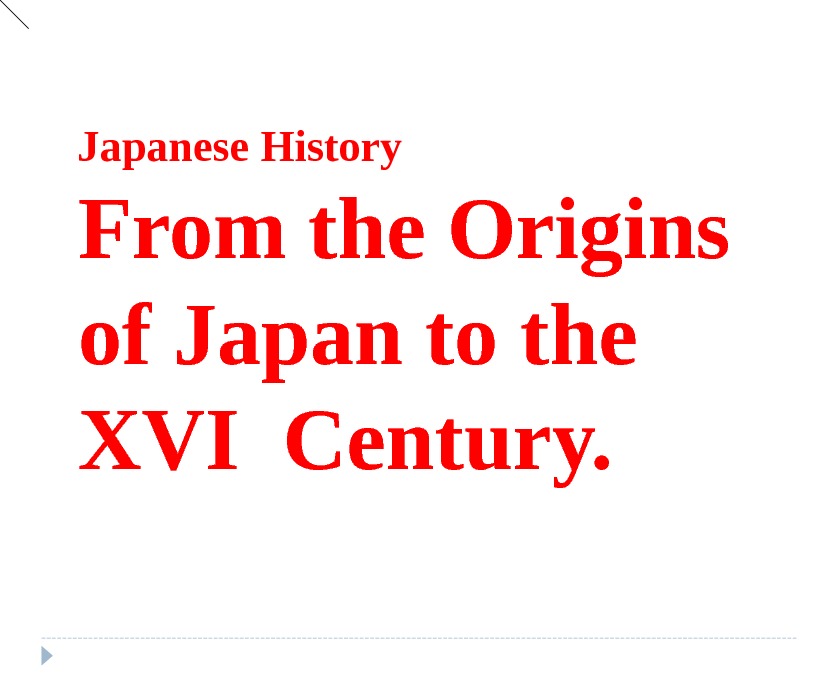
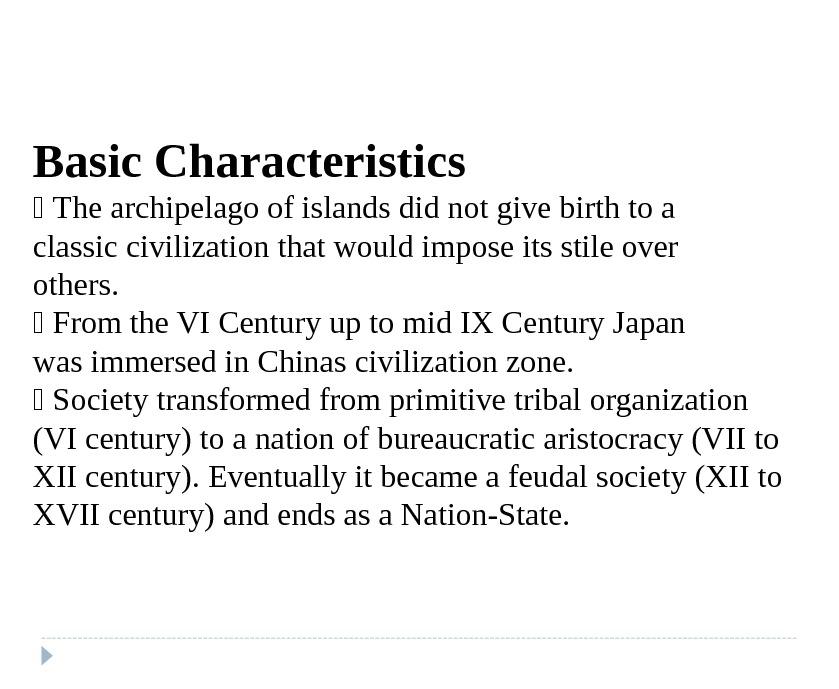
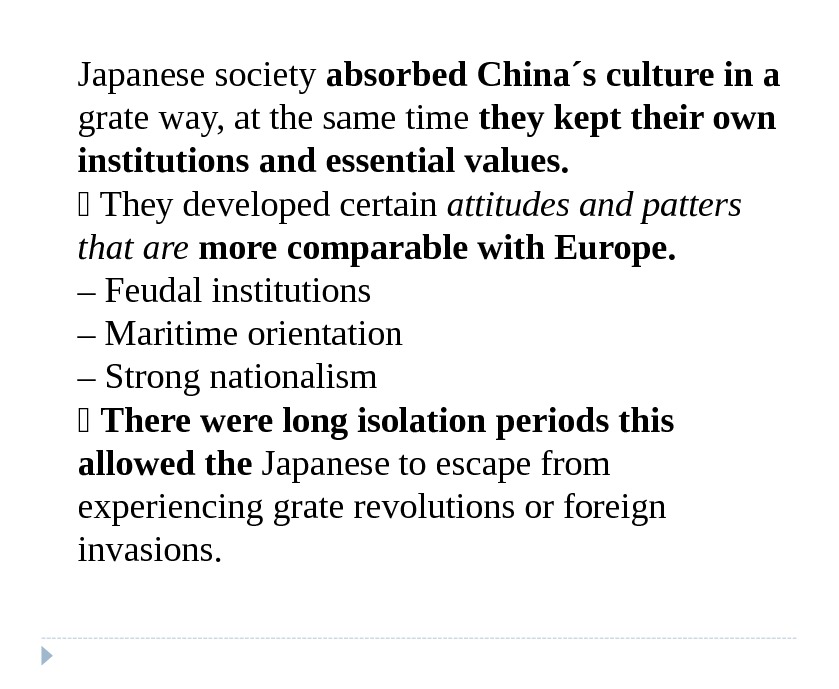
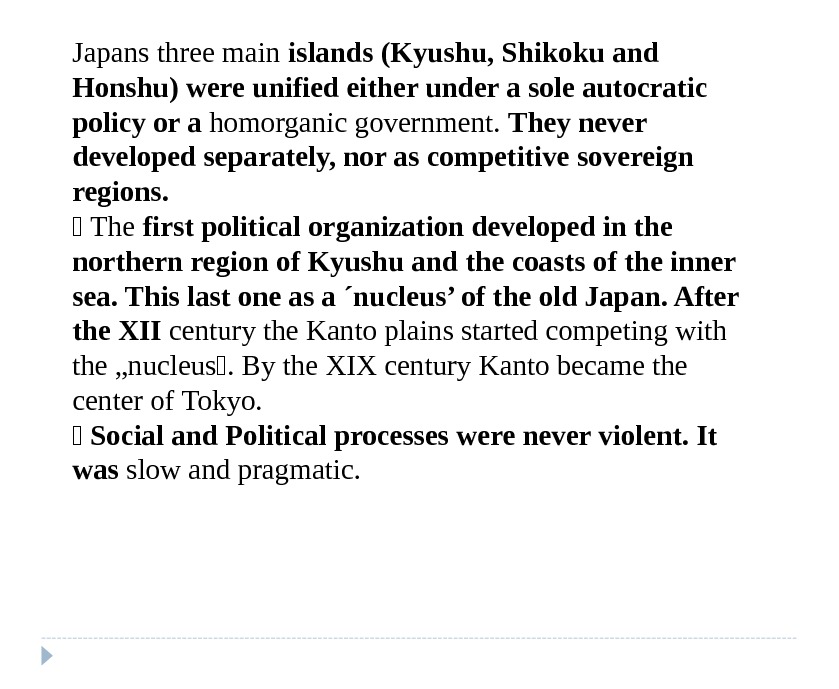
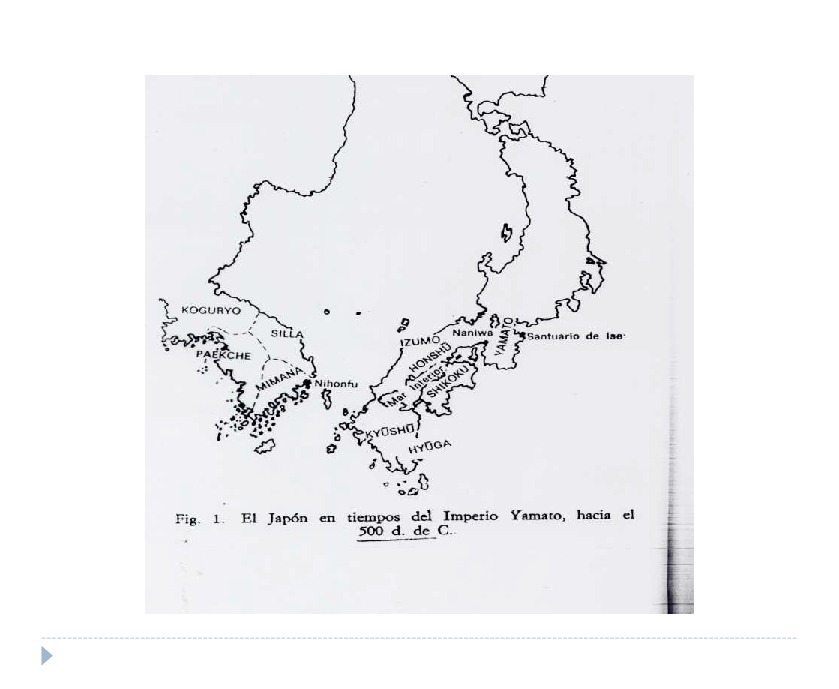
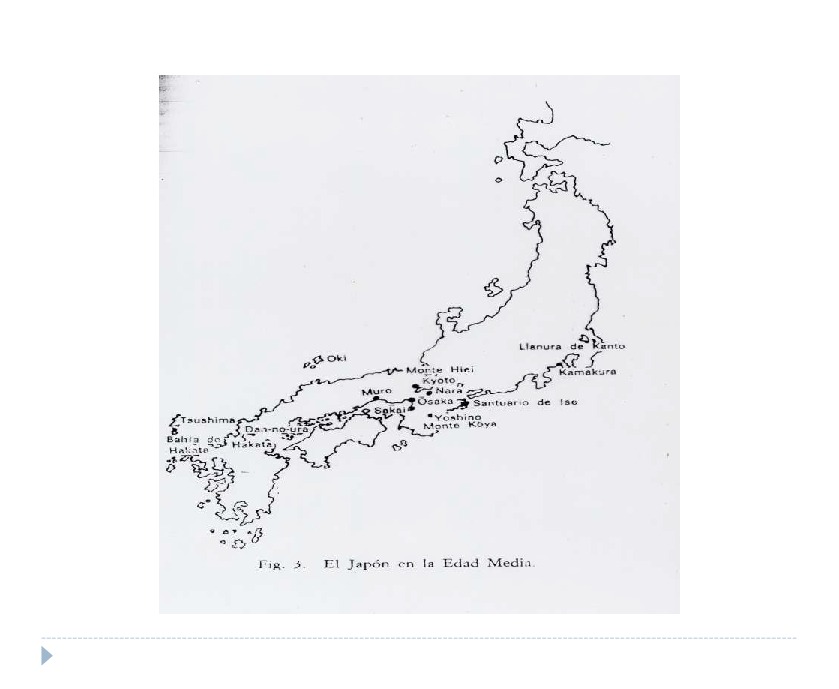
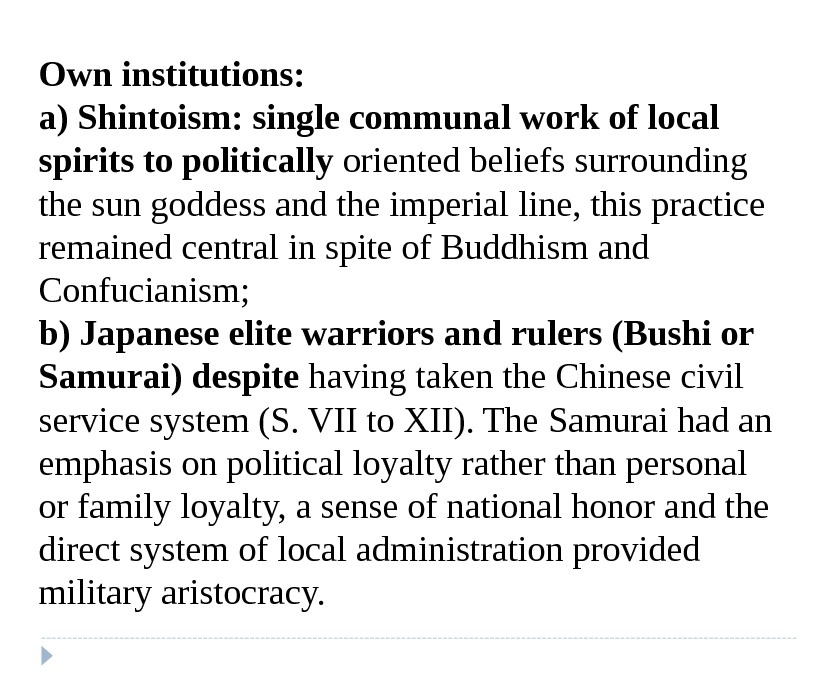
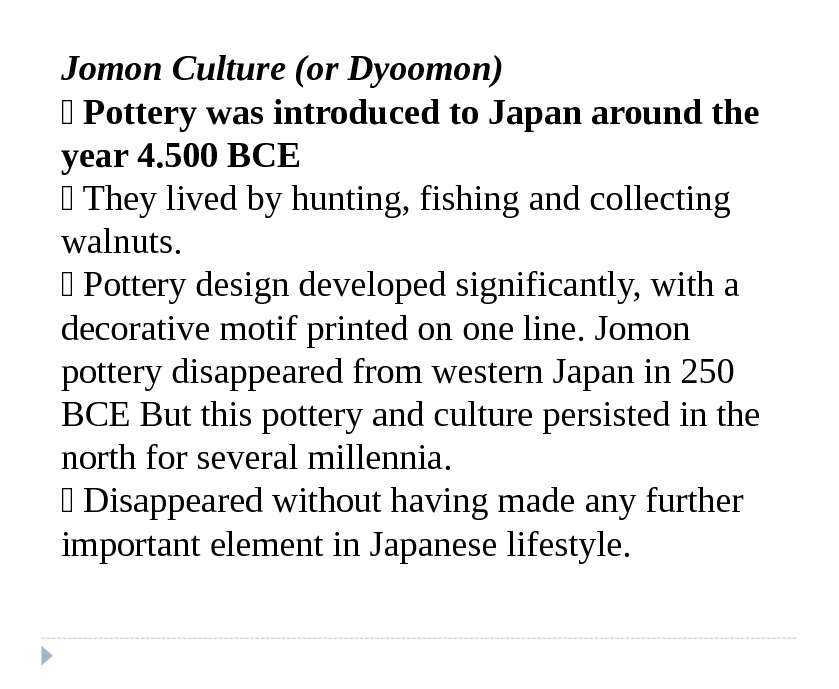
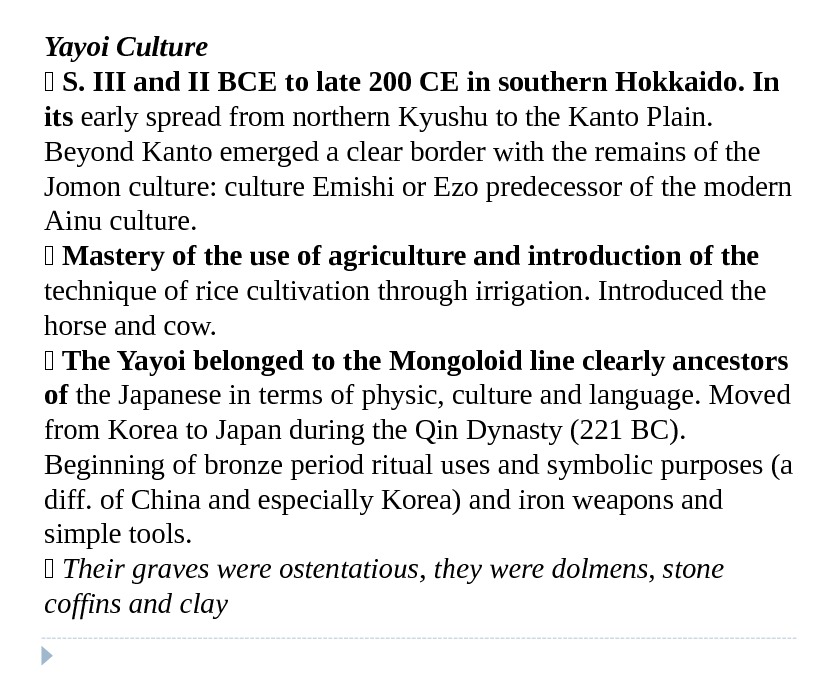
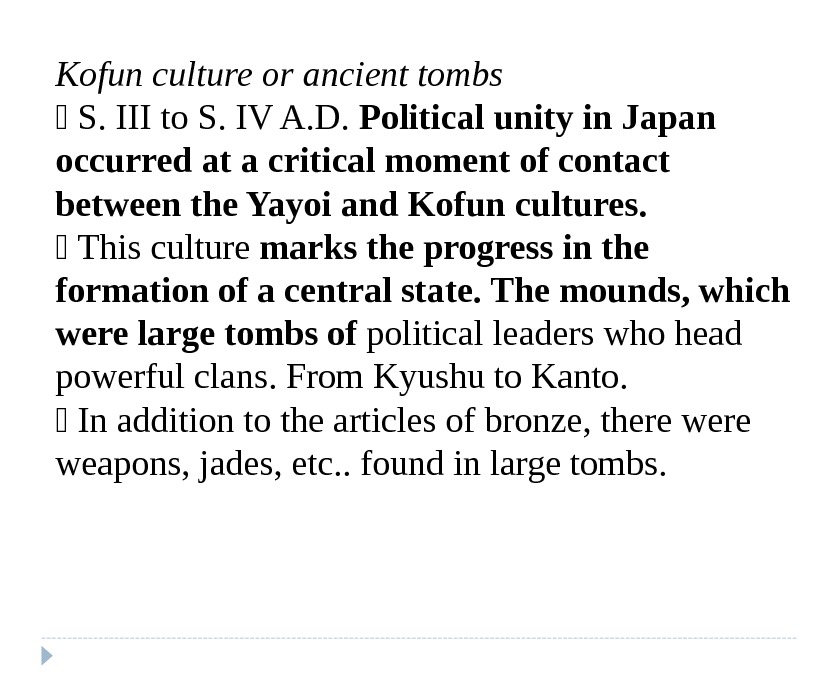
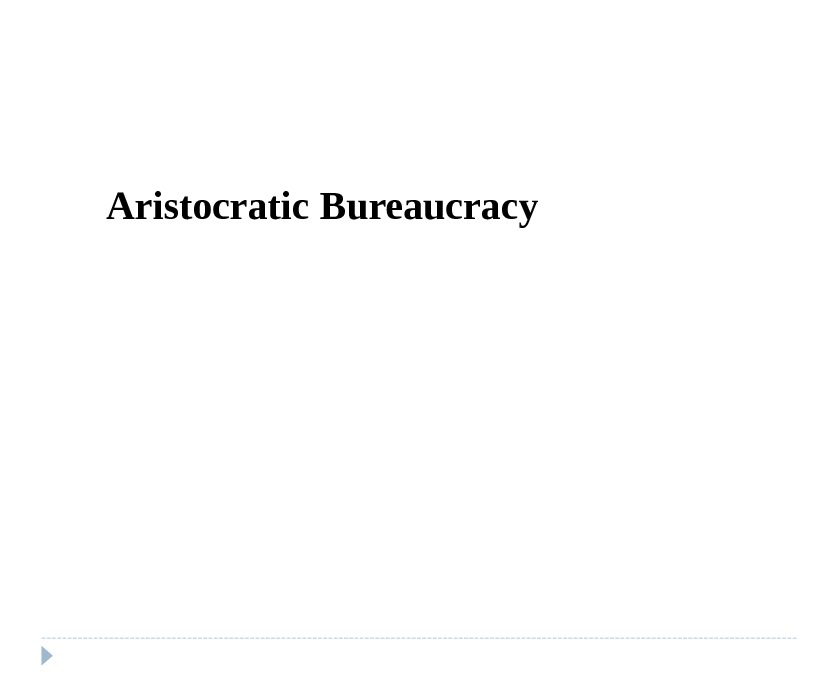
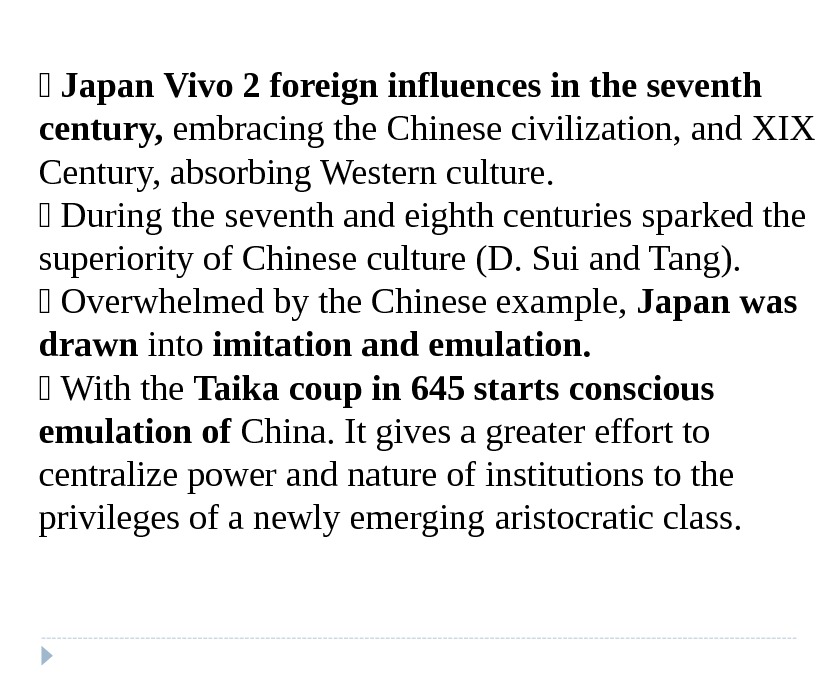
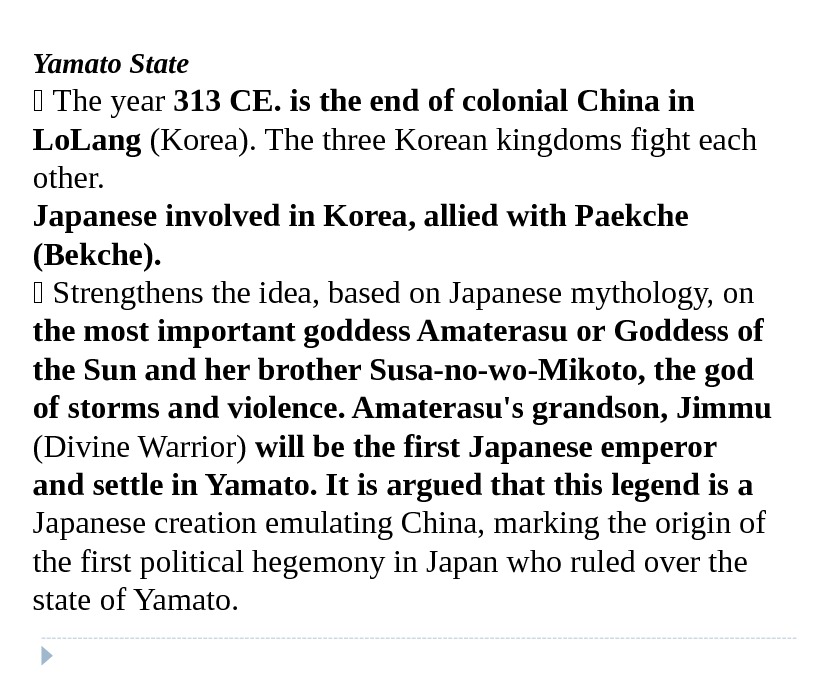
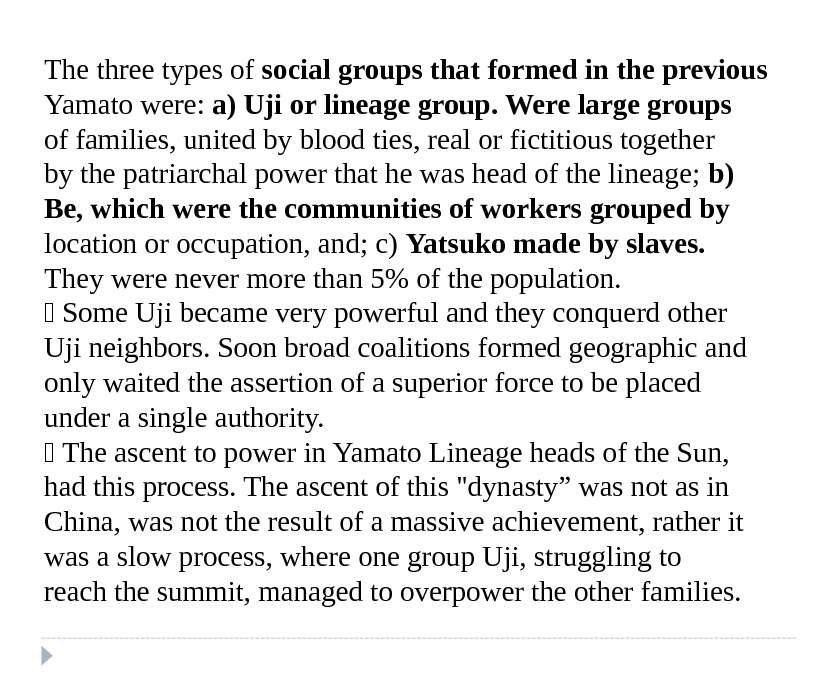
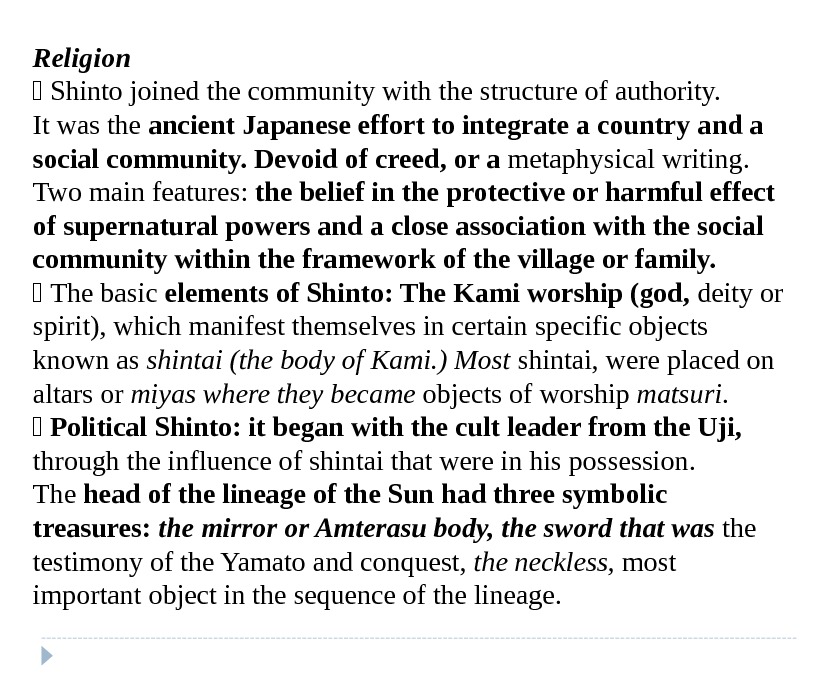
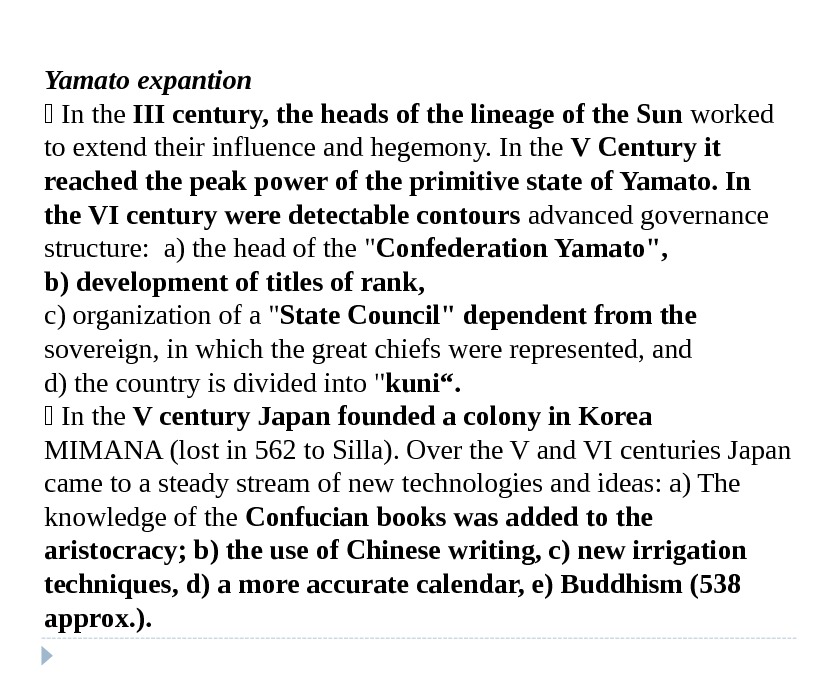
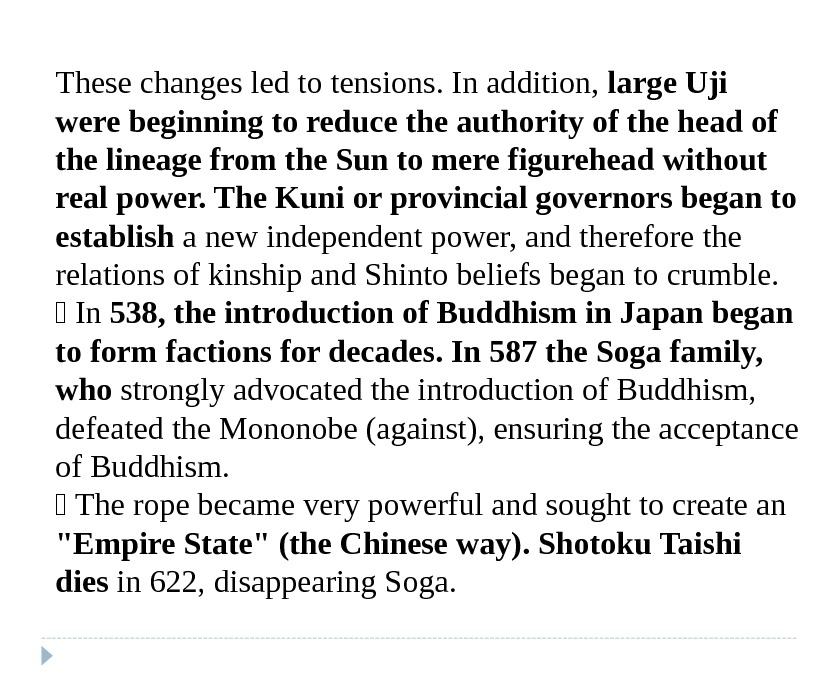
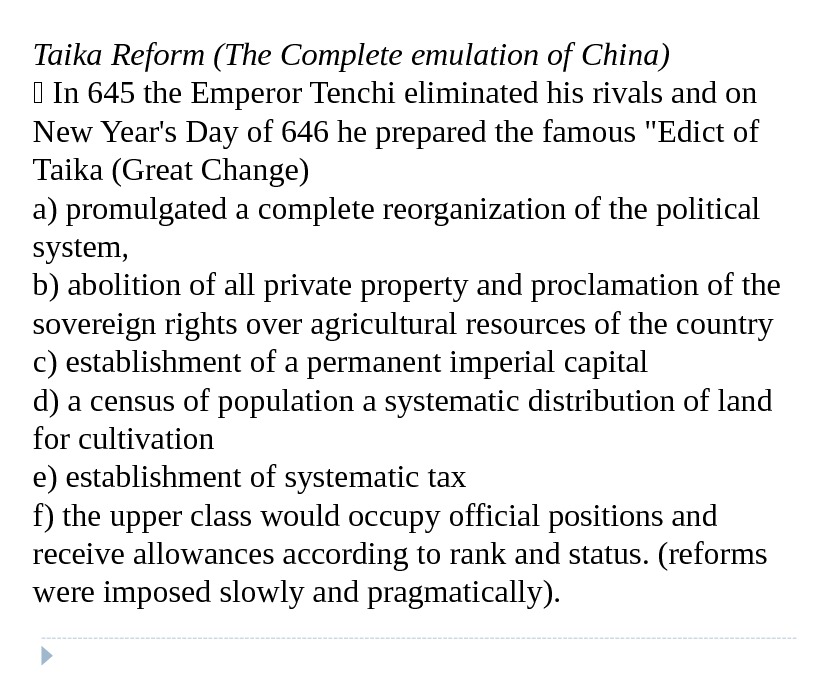
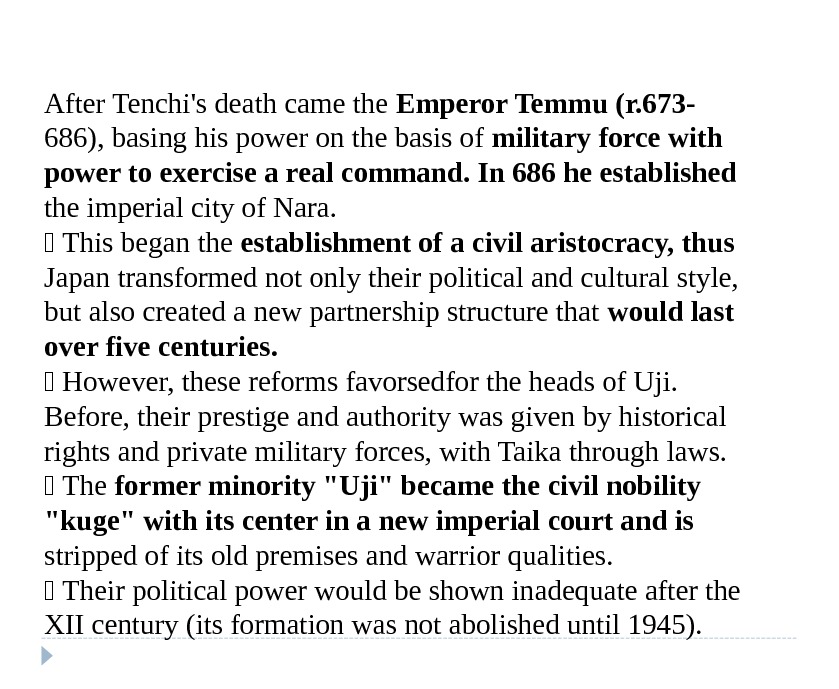
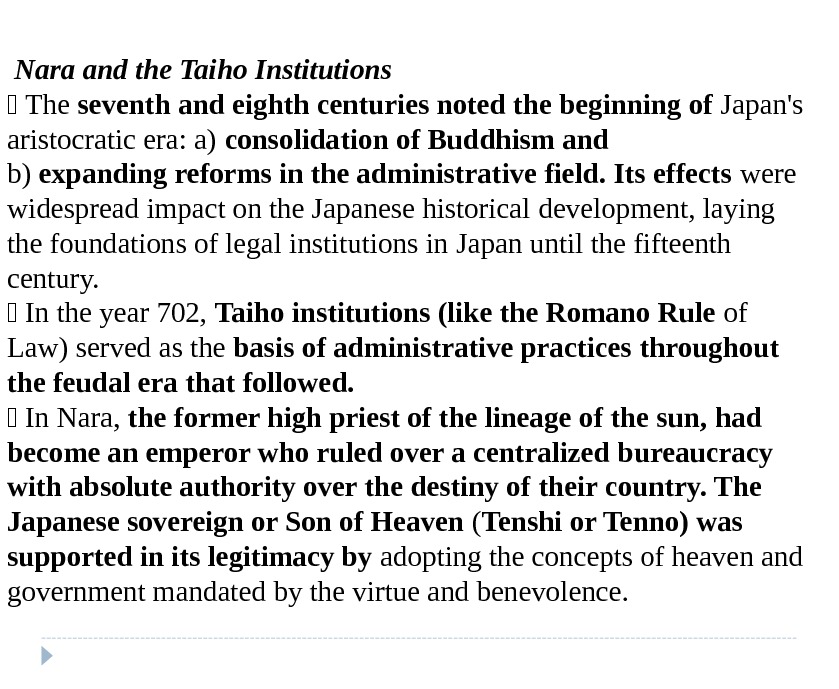
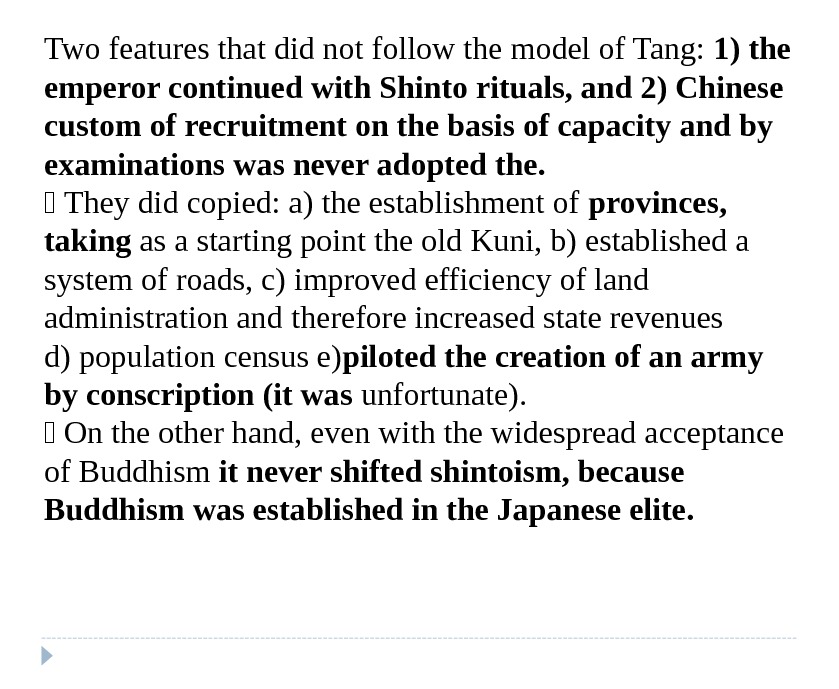
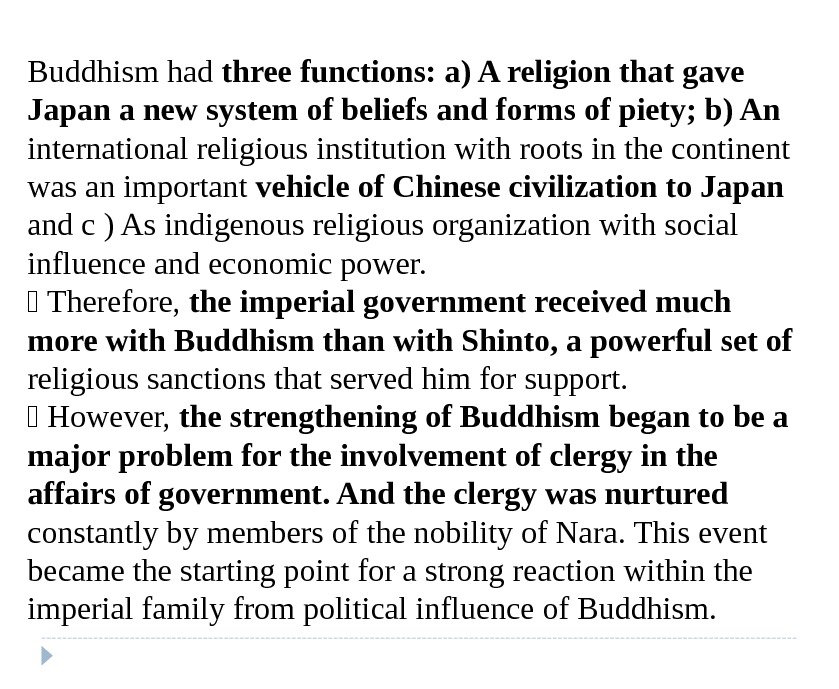
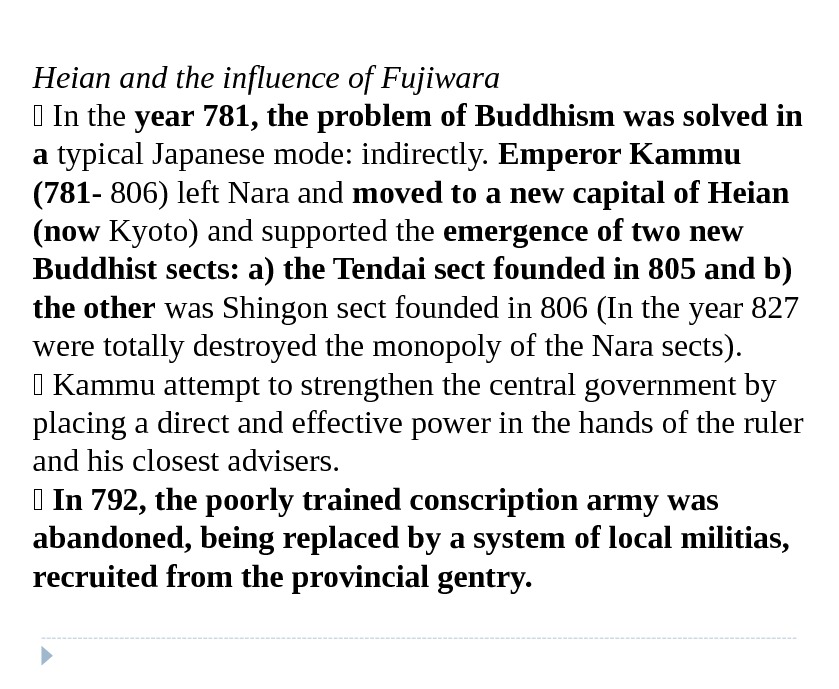
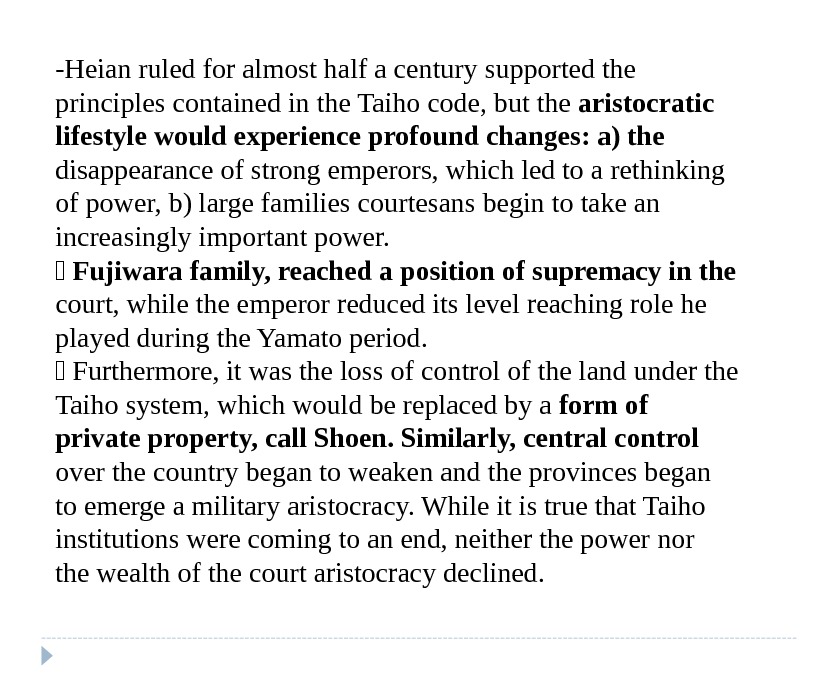
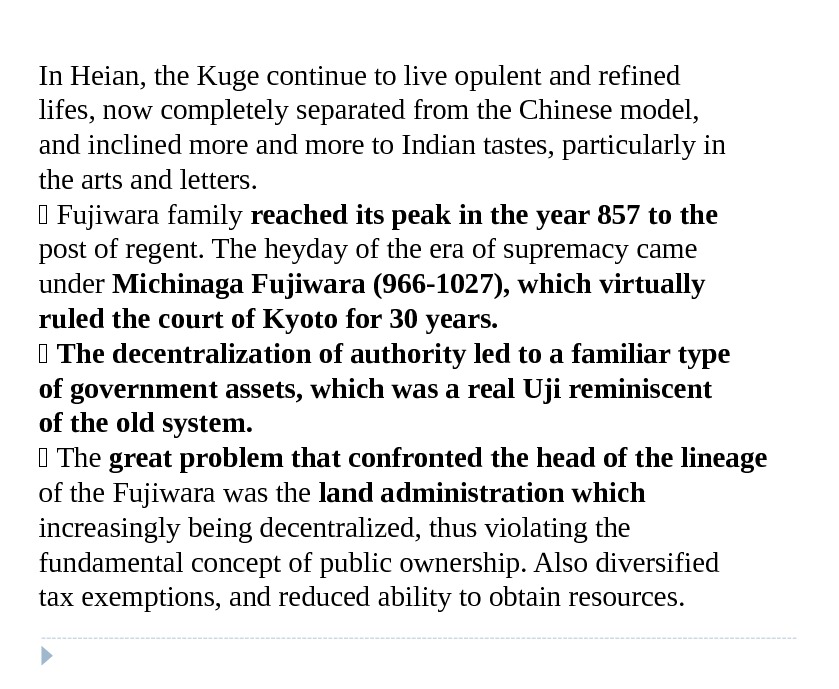

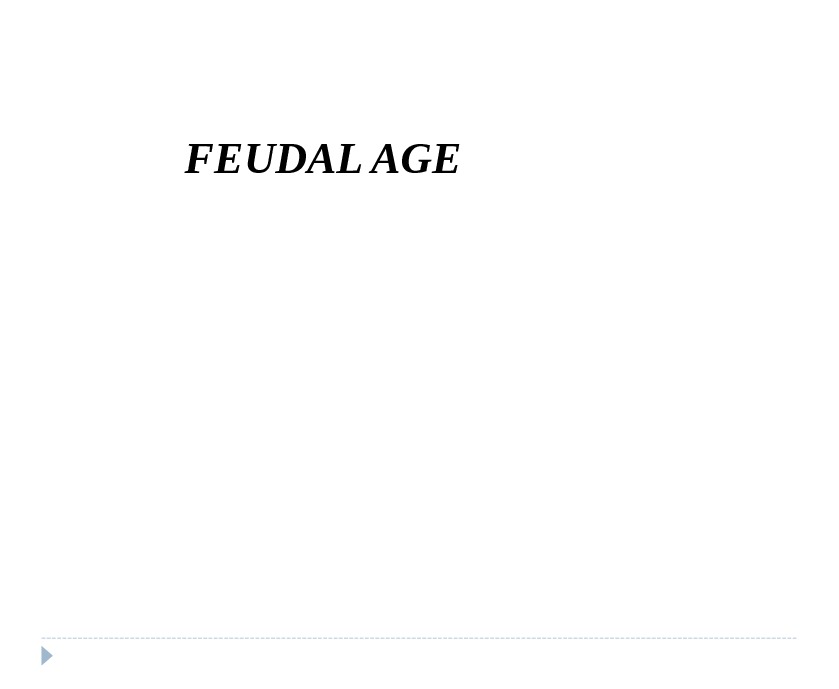
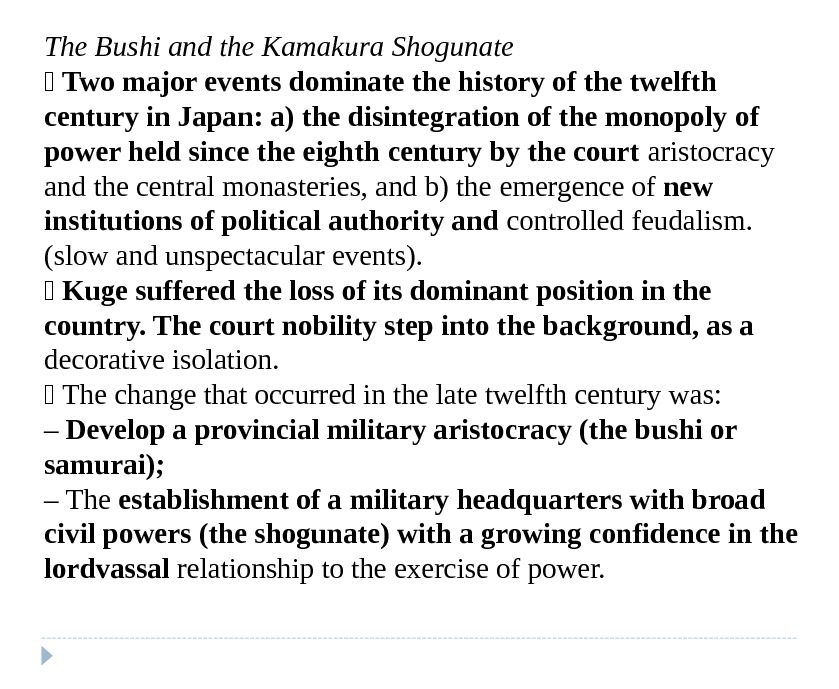
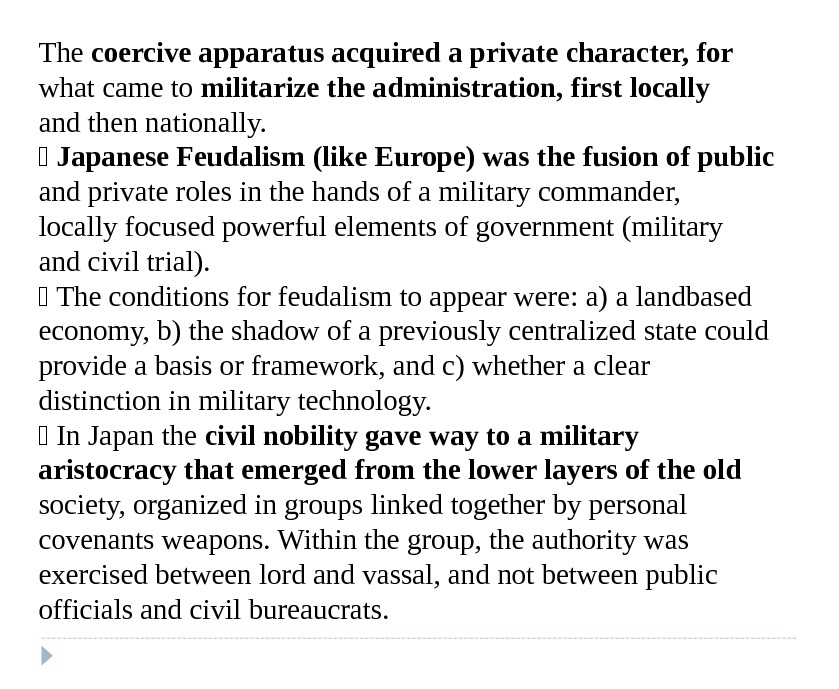
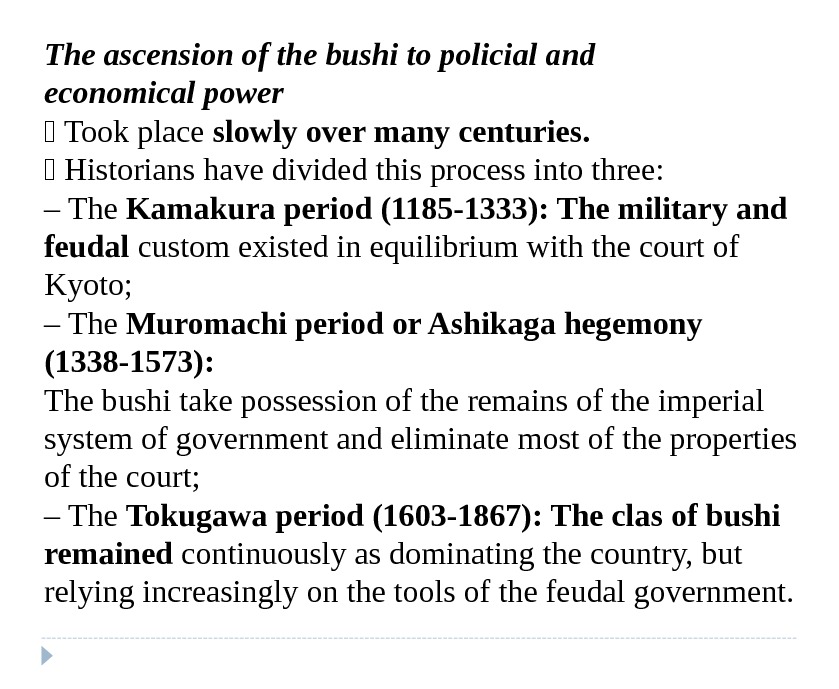
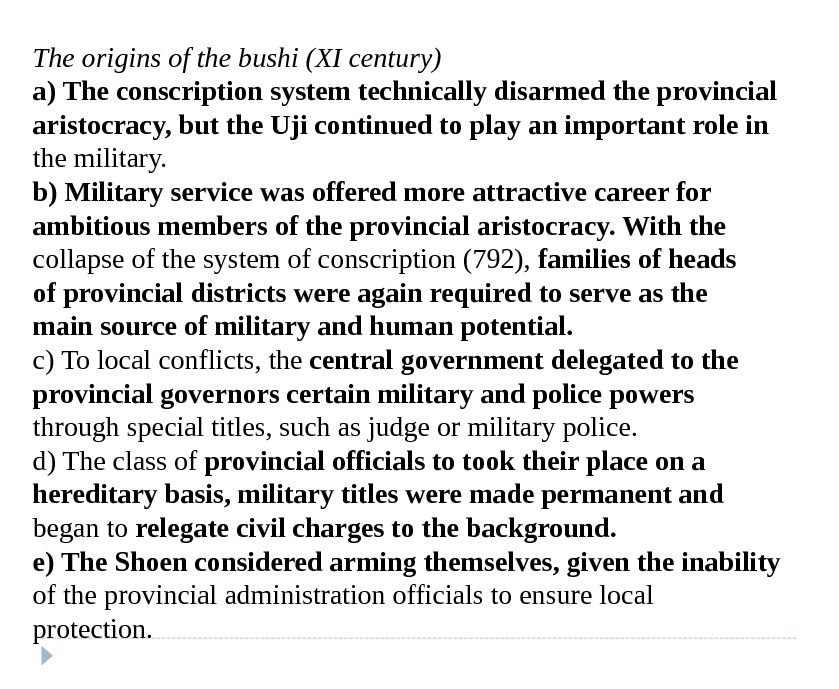
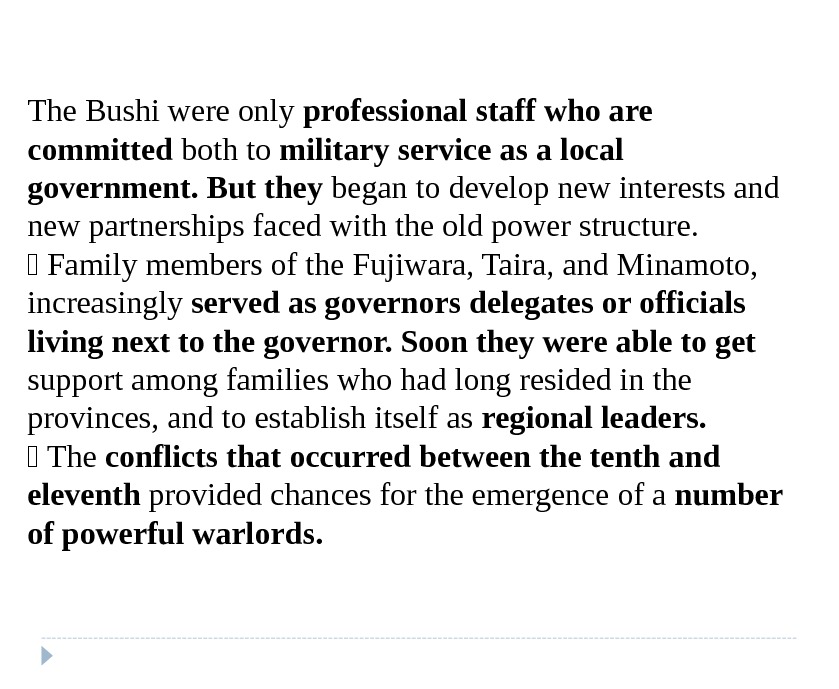
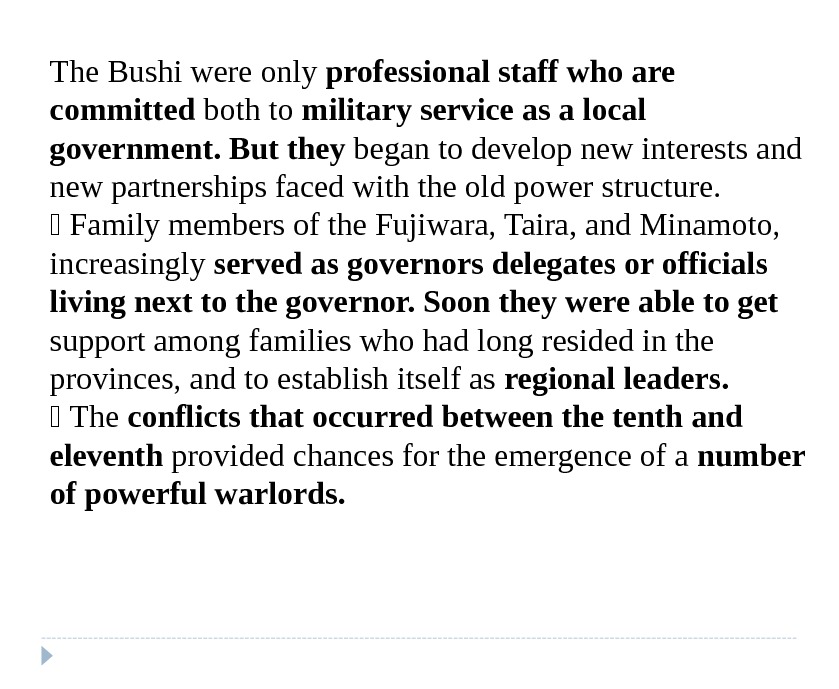
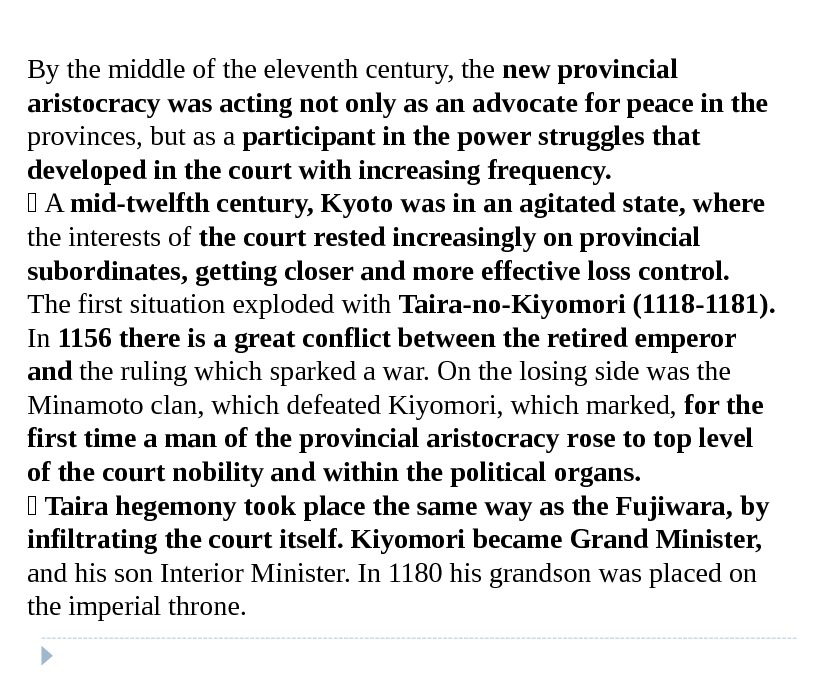
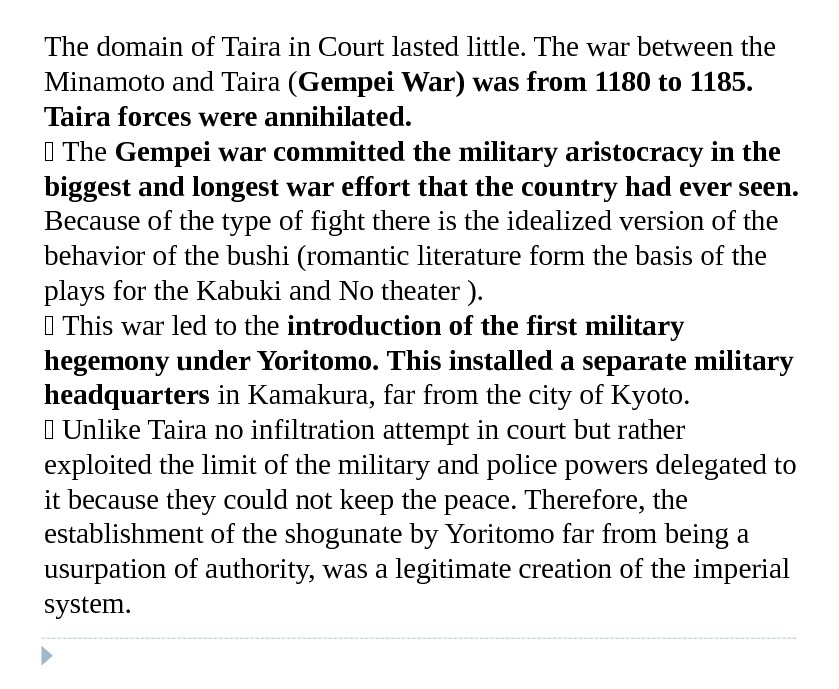
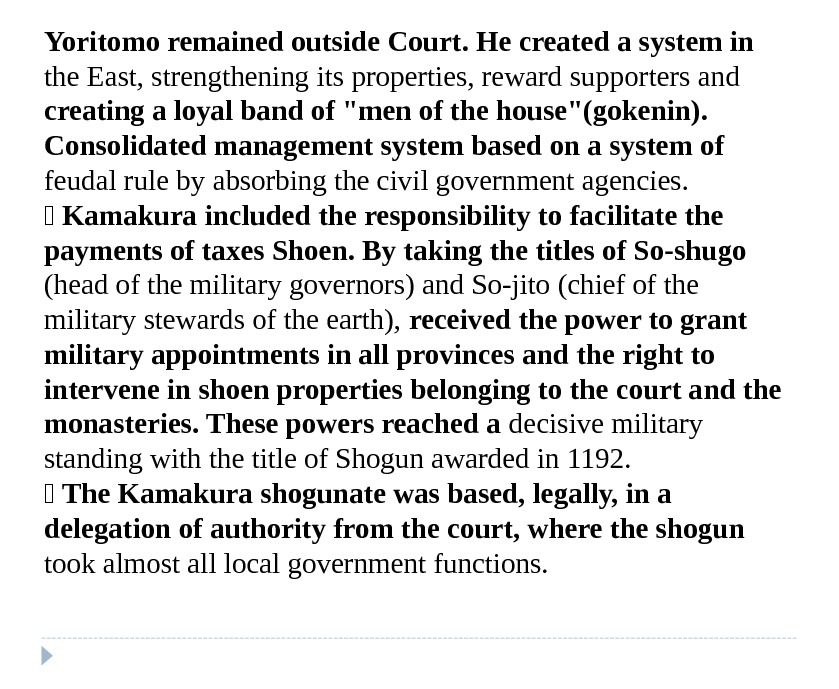
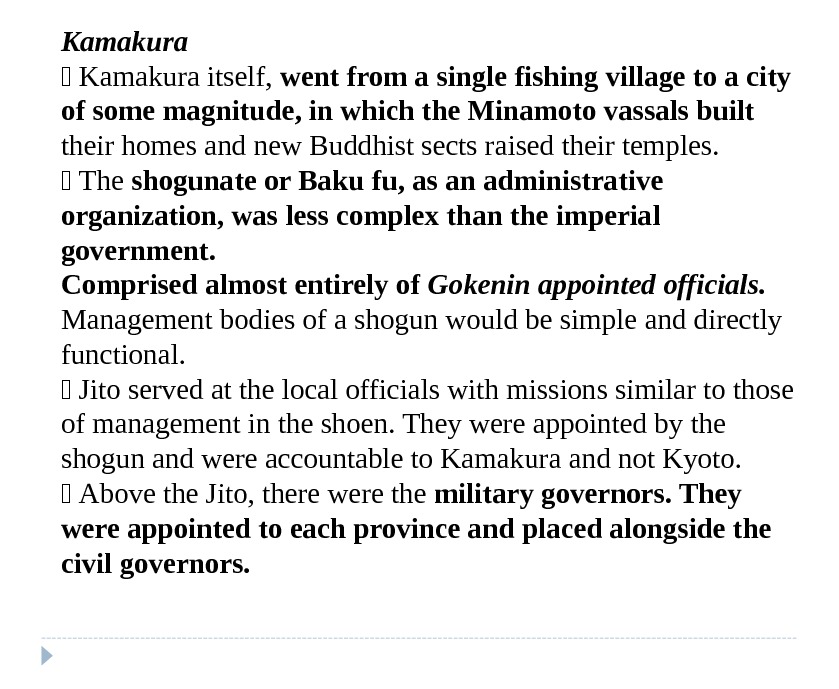
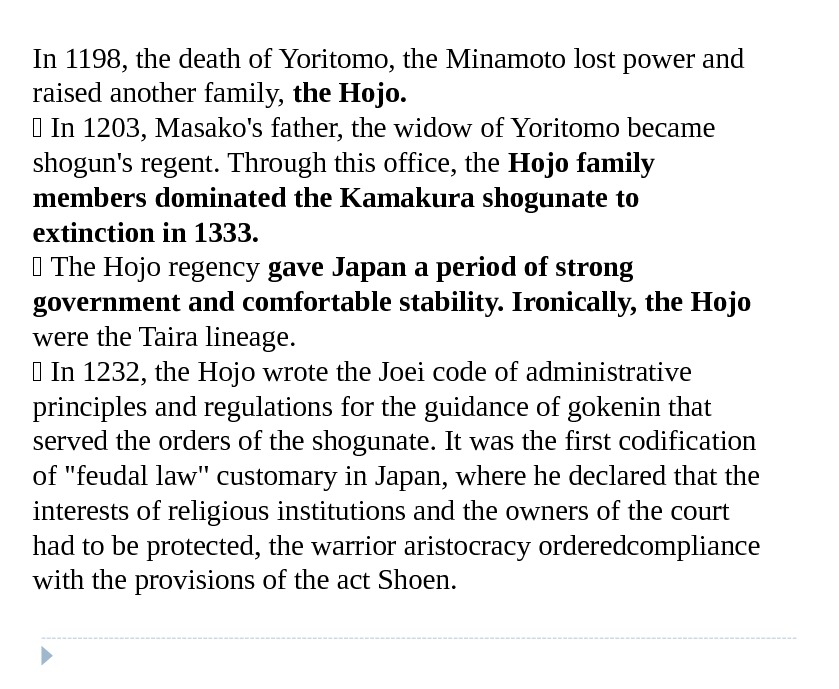
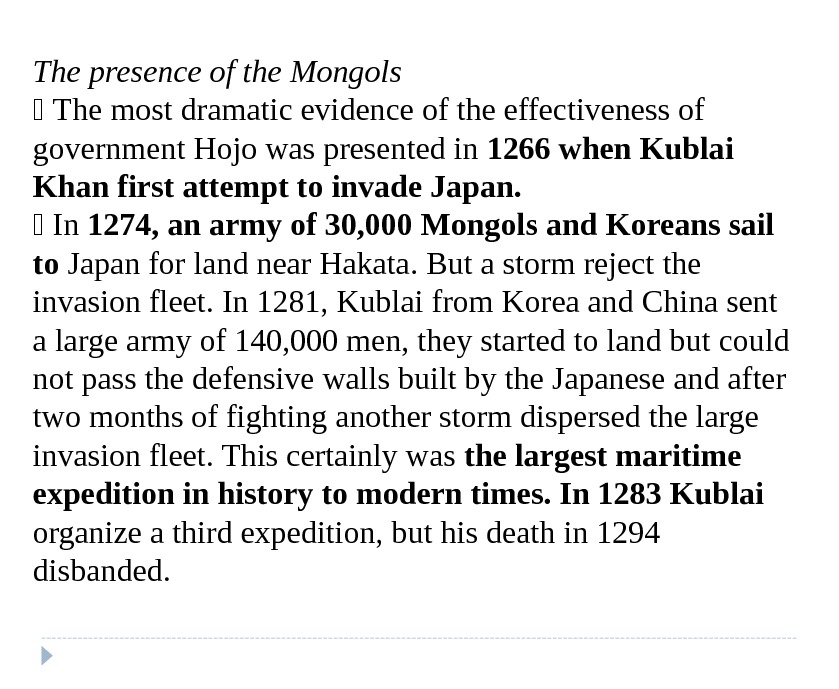
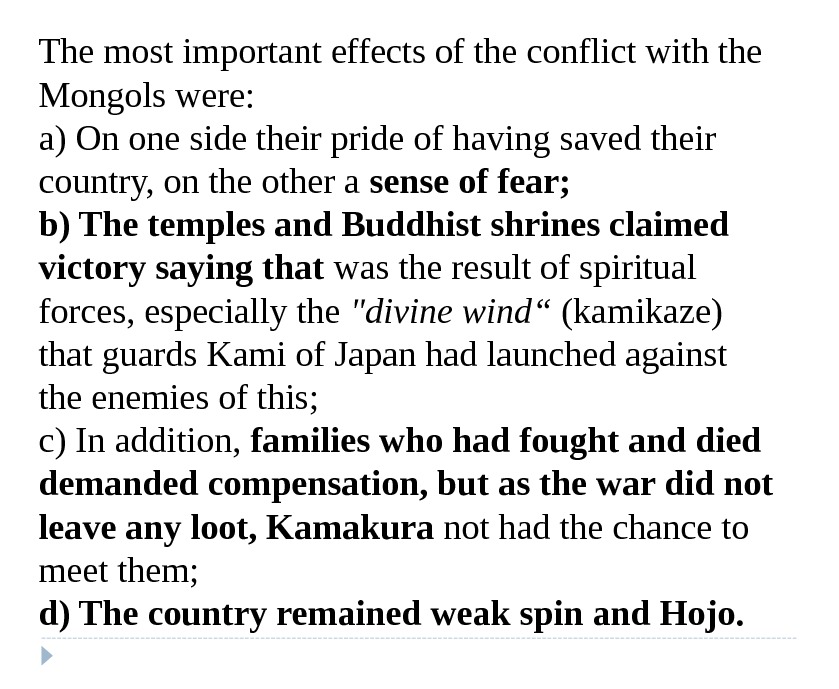
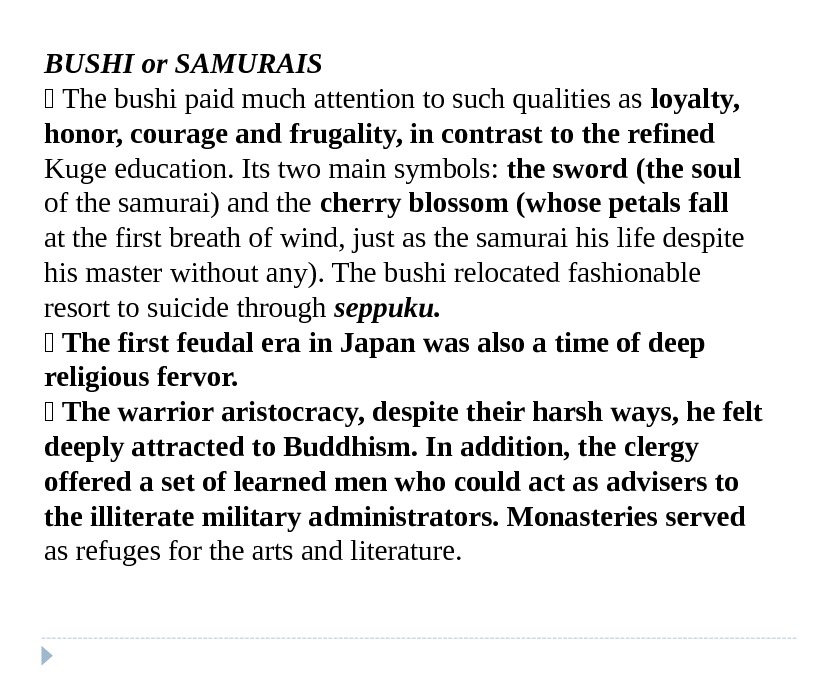
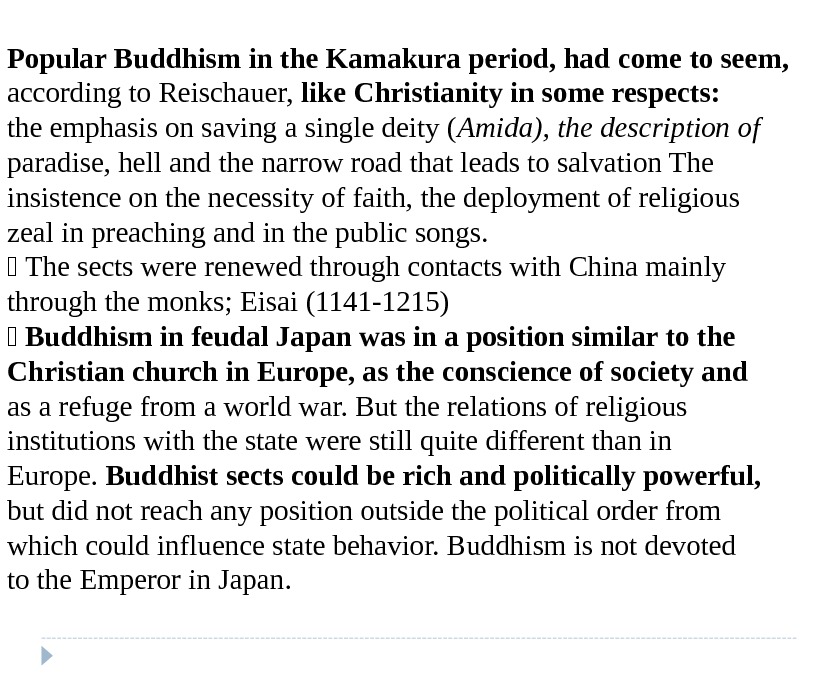
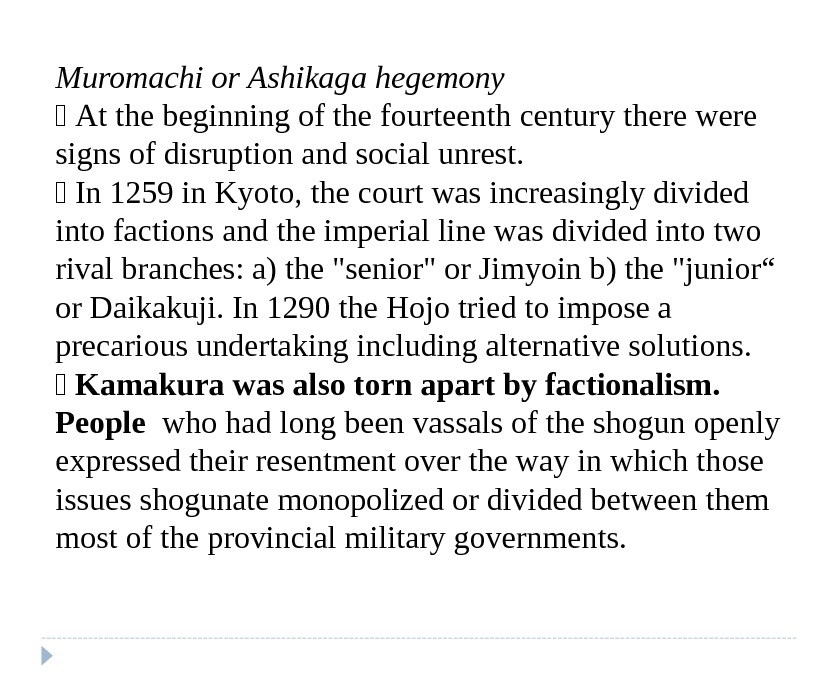
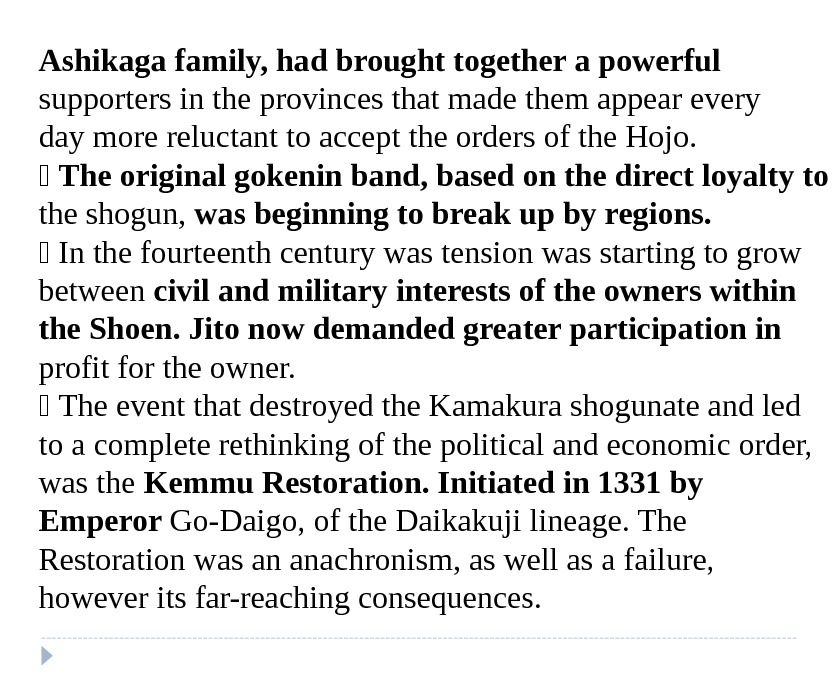
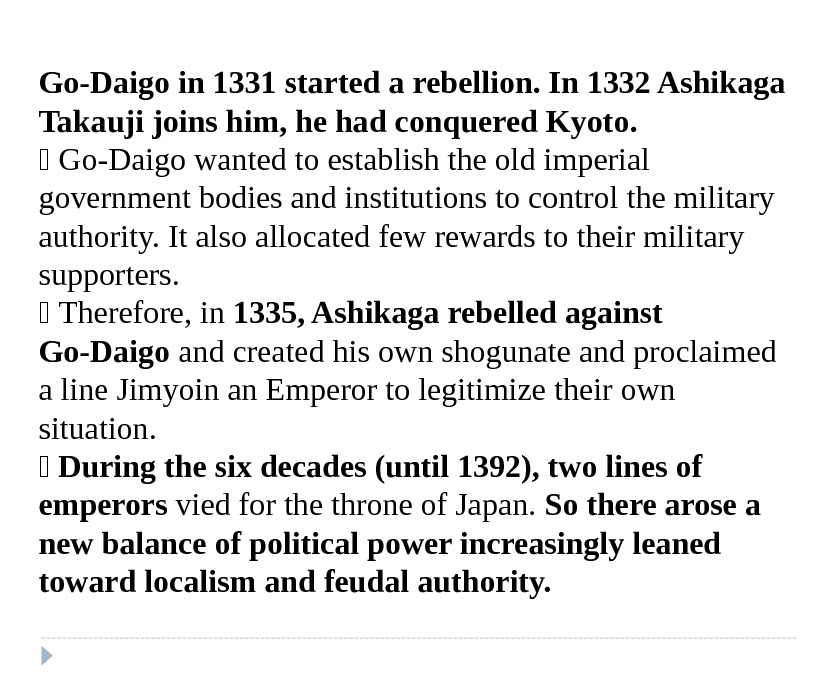
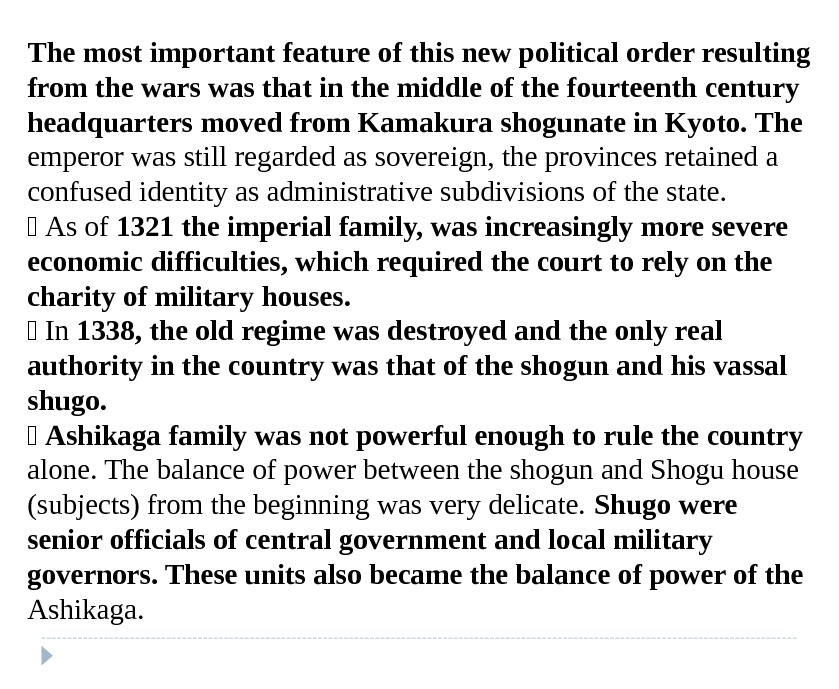
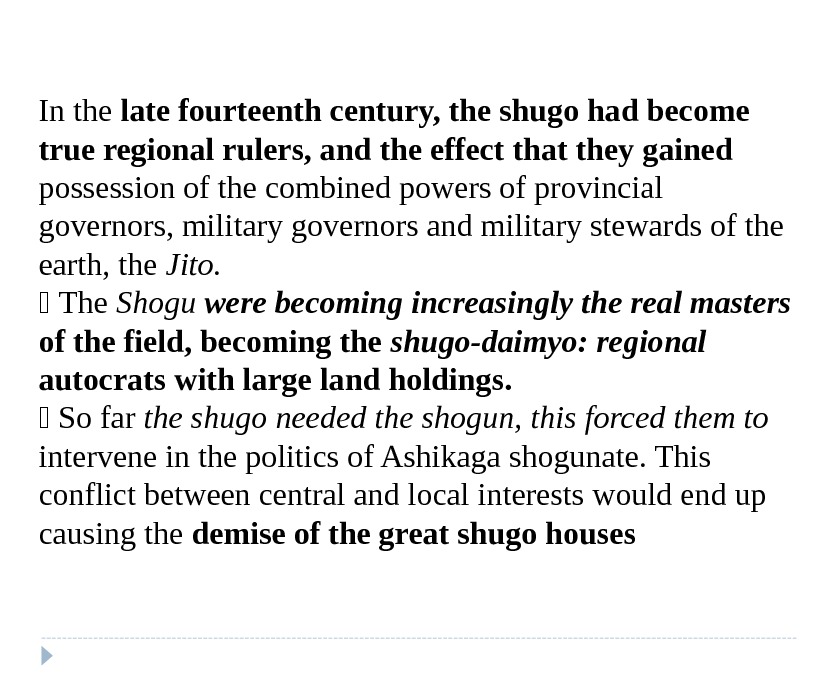
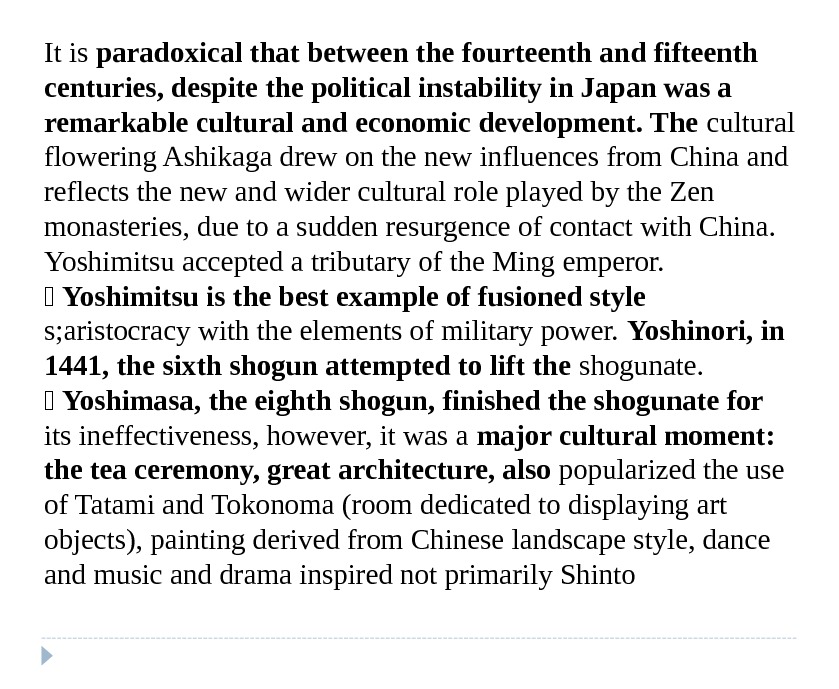
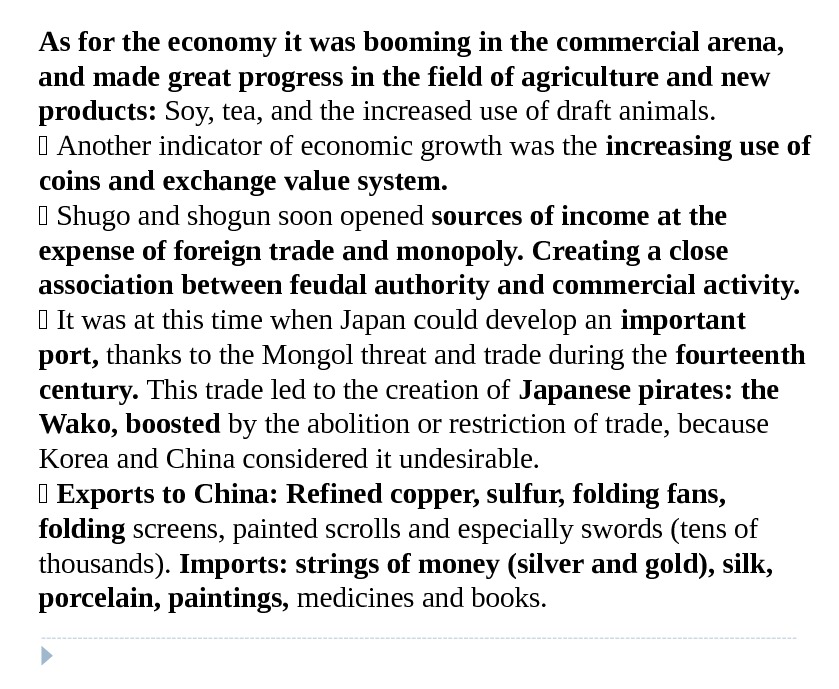
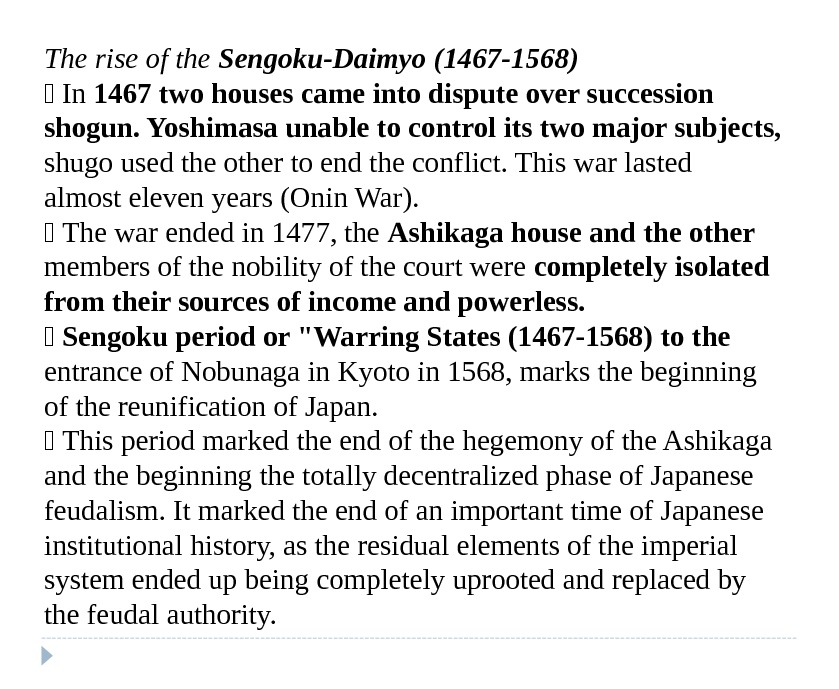
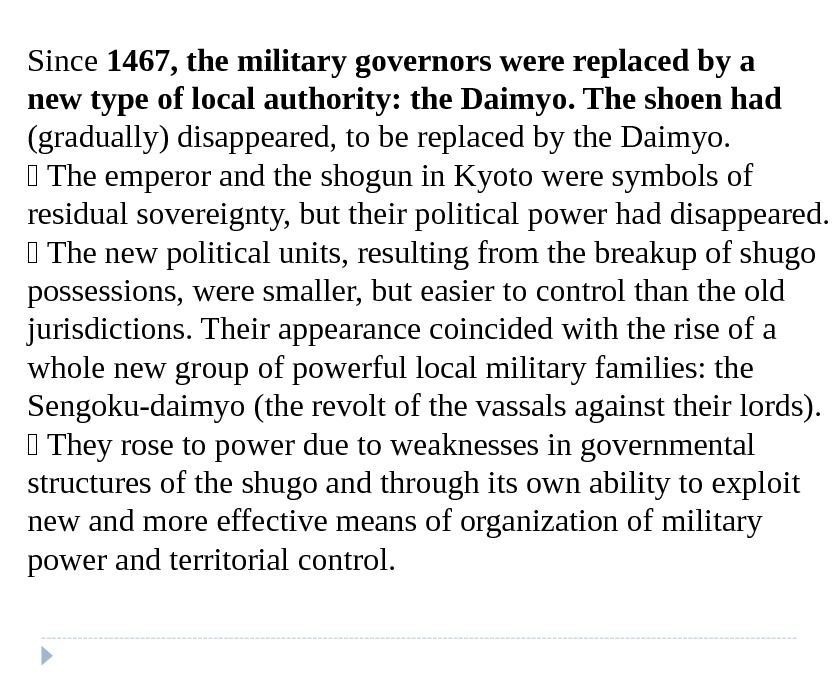
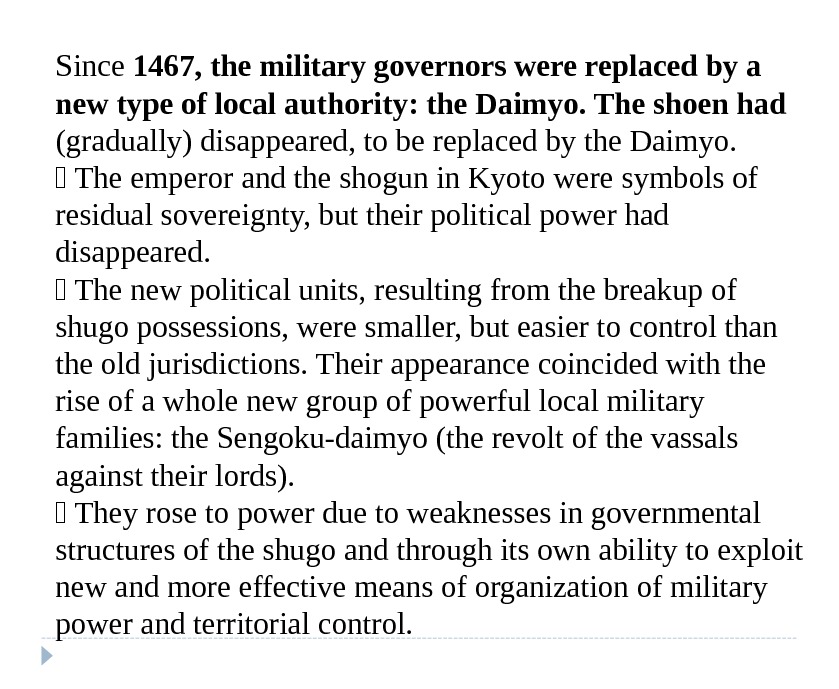
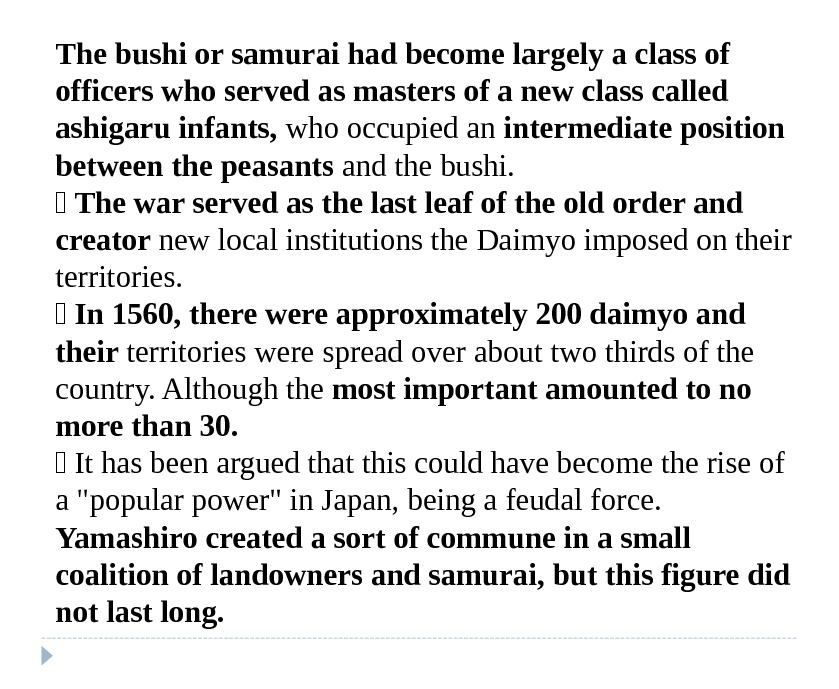
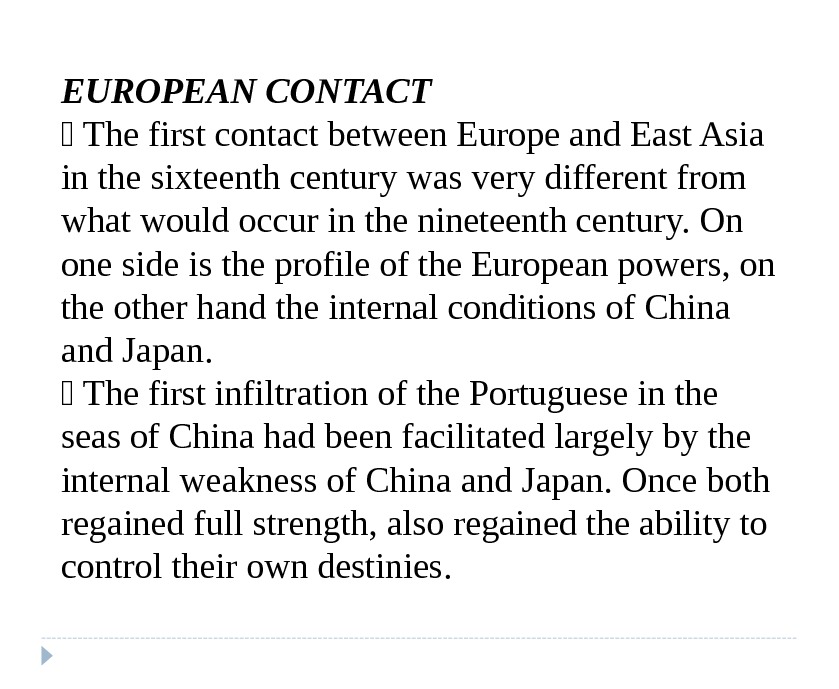
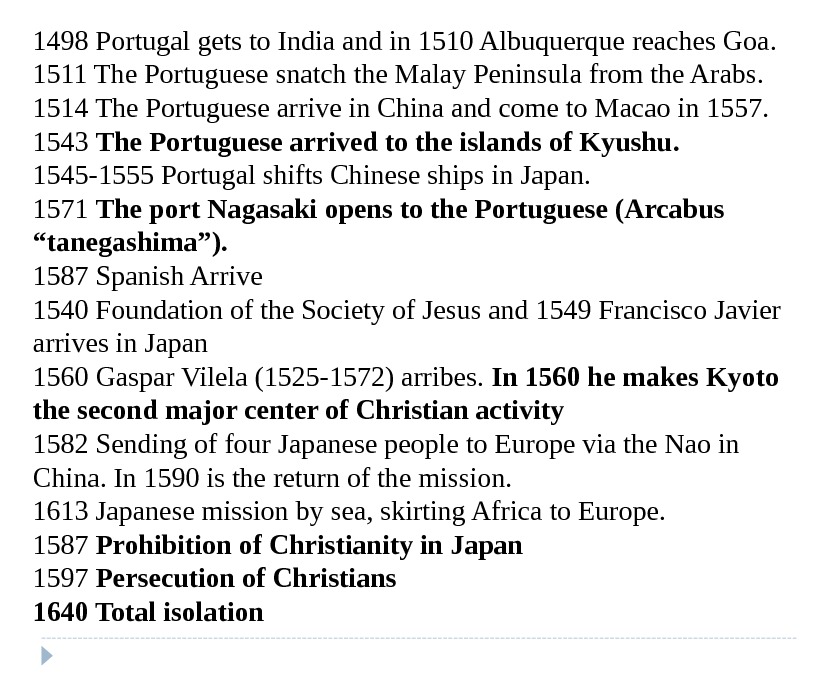
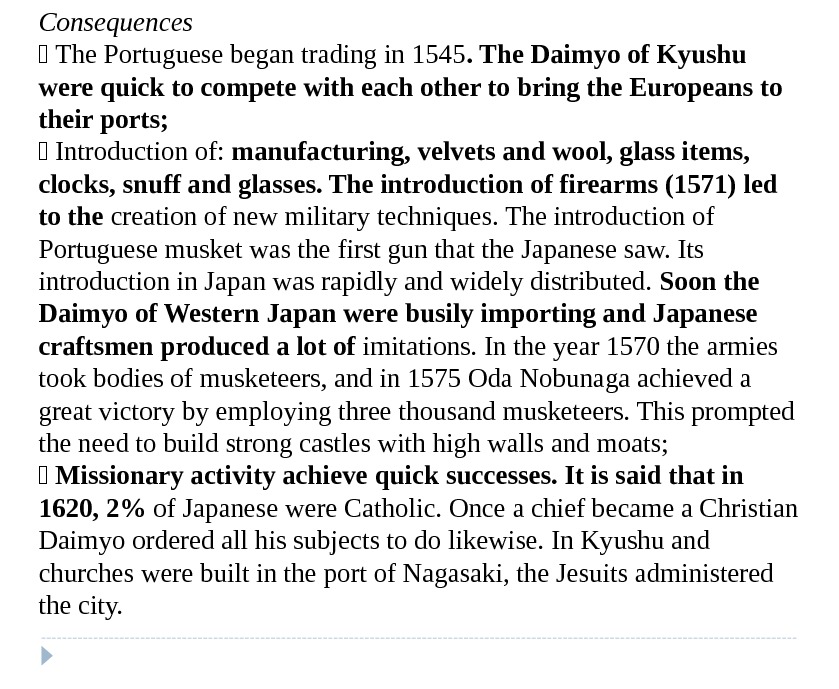
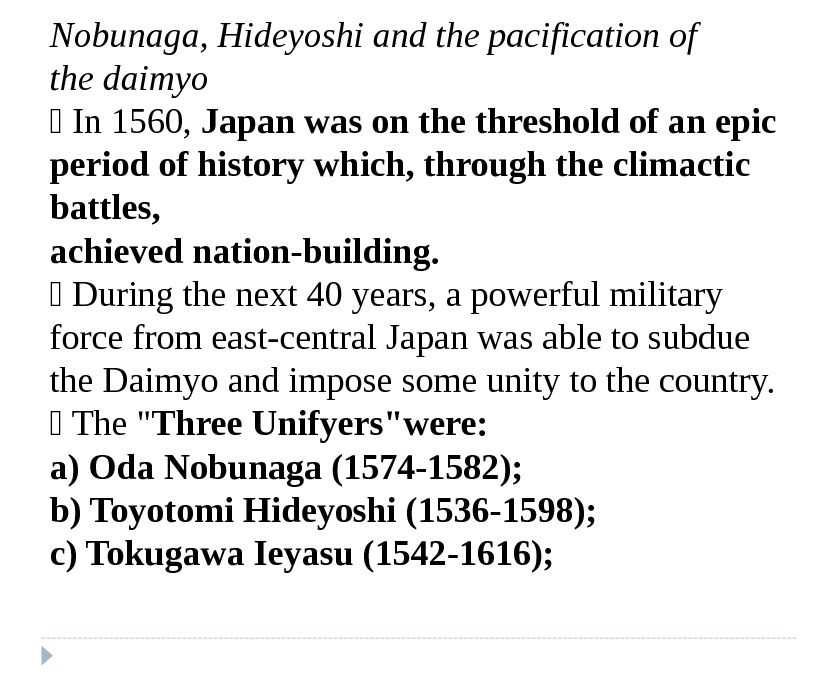
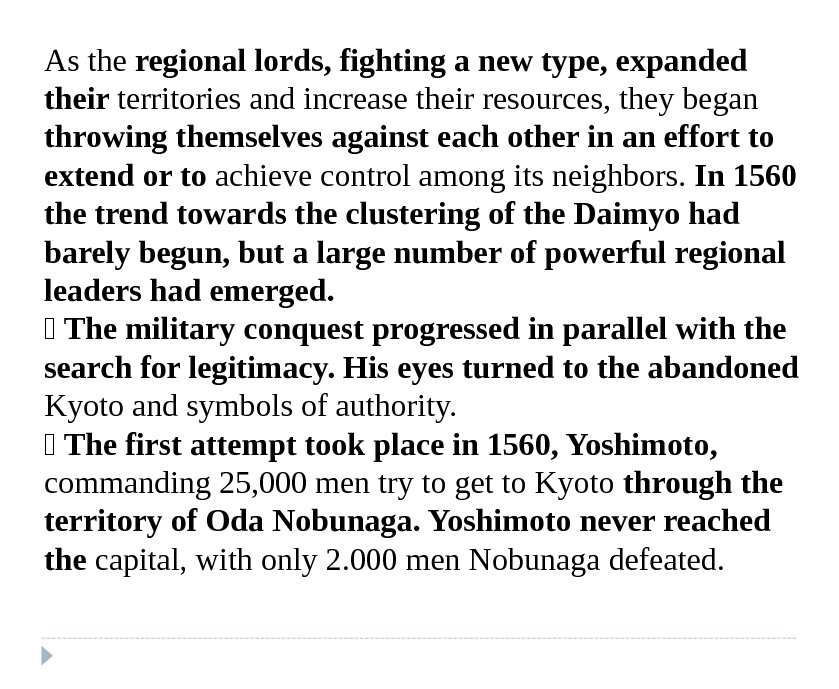
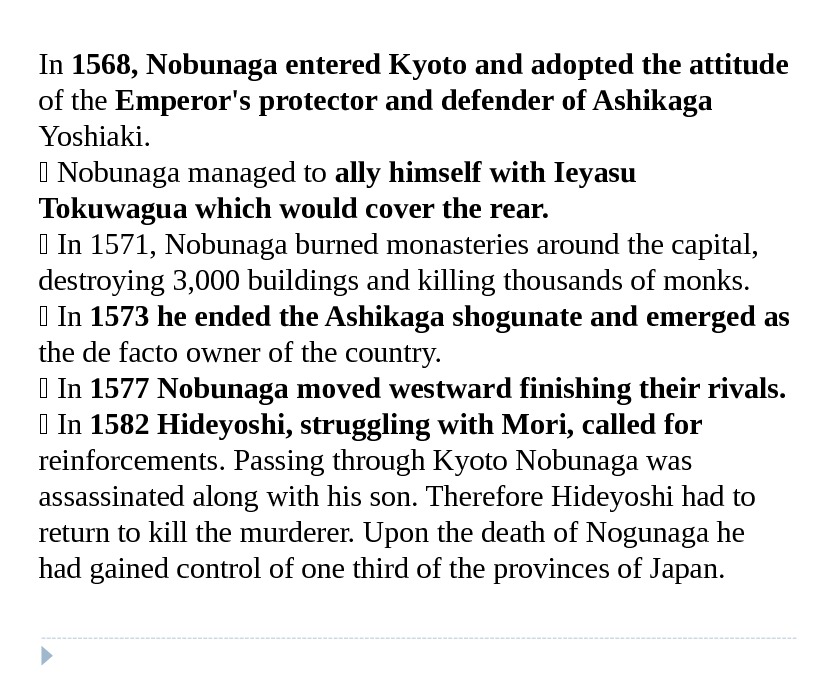
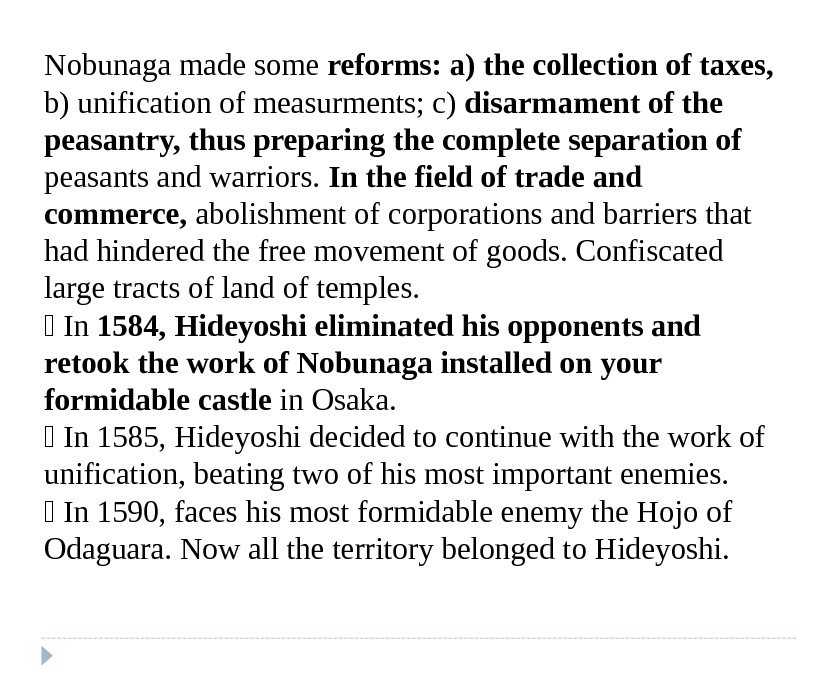
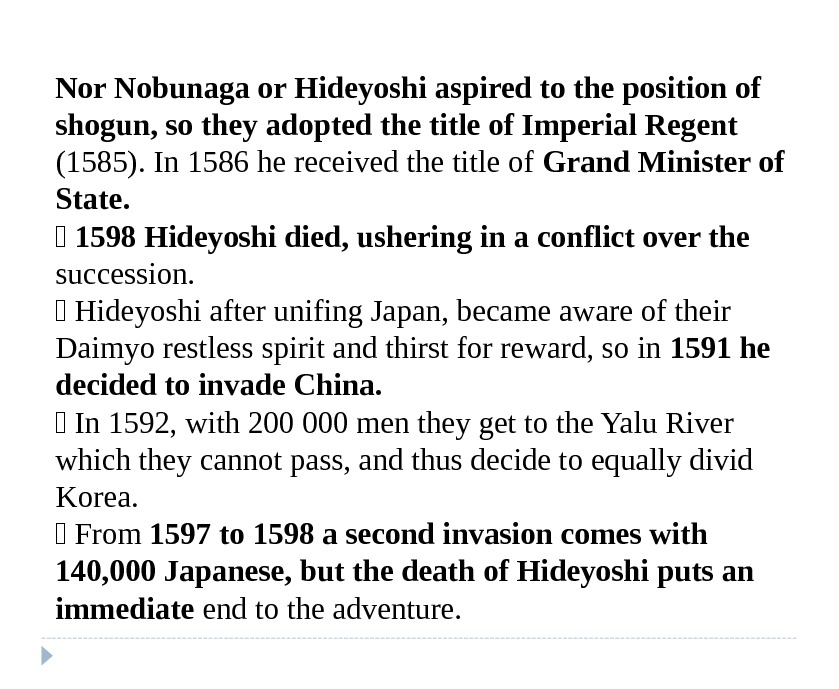

augan_japanece_history_untill_xyi_century.ppt
- Размер: 1 Mегабайта
- Количество слайдов: 62
Описание презентации Japanese History From the Origins of Japan по слайдам
 Japanese History From the Origins of Japan to the XVI Century.
Japanese History From the Origins of Japan to the XVI Century.
 Basic Characteristics The archipelago of islands did not give birth to a classic civilization that would impose its stile over others. From the VI Century up to mid IX Century Japan was immersed in Chinas civilization zone. Society transformed from primitive tribal organization (VI century) to a nation of bureaucratic aristocracy (VII to XII century). Eventually it became a feudal society (XII to XVII century) and ends as a Nation-State.
Basic Characteristics The archipelago of islands did not give birth to a classic civilization that would impose its stile over others. From the VI Century up to mid IX Century Japan was immersed in Chinas civilization zone. Society transformed from primitive tribal organization (VI century) to a nation of bureaucratic aristocracy (VII to XII century). Eventually it became a feudal society (XII to XVII century) and ends as a Nation-State.
 Japanese society absorbed China´s culture in a grate way, at the same time they kept their own institutions and essential values. They developed certain attitudes and patters that are more comparable with Europe. – Feudal institutions – Maritime orientation – Strong nationalism There were long isolation periods this allowed the Japanese to escape from experiencing grate revolutions or foreign invasions.
Japanese society absorbed China´s culture in a grate way, at the same time they kept their own institutions and essential values. They developed certain attitudes and patters that are more comparable with Europe. – Feudal institutions – Maritime orientation – Strong nationalism There were long isolation periods this allowed the Japanese to escape from experiencing grate revolutions or foreign invasions.
 Japans three main islands (Kyushu, Shikoku and Honshu) were unified either under a sole autocratic policy or a homorganic government. They never developed separately, nor as competitive sovereign regions. The first political organization developed in the northern region of Kyushu and the coasts of the inner sea. This last one as a ´nucleus’ of the old Japan. After the XII century the Kanto plains started competing with the „nucleus. By the XIX century Kanto became the center of Tokyo. Social and Political processes were never violent. It was slow and pragmatic.
Japans three main islands (Kyushu, Shikoku and Honshu) were unified either under a sole autocratic policy or a homorganic government. They never developed separately, nor as competitive sovereign regions. The first political organization developed in the northern region of Kyushu and the coasts of the inner sea. This last one as a ´nucleus’ of the old Japan. After the XII century the Kanto plains started competing with the „nucleus. By the XIX century Kanto became the center of Tokyo. Social and Political processes were never violent. It was slow and pragmatic.


 Own institutions: a) Shintoism: single communal work of local spirits to politically oriented beliefs surrounding the sun goddess and the imperial line, this practice remained central in spite of Buddhism and Confucianism; b) Japanese elite warriors and rulers (Bushi or Samurai) despite having taken the Chinese civil service system (S. VII to XII). The Samurai had an emphasis on political loyalty rather than personal or family loyalty, a sense of national honor and the direct system of local administration provided military aristocracy.
Own institutions: a) Shintoism: single communal work of local spirits to politically oriented beliefs surrounding the sun goddess and the imperial line, this practice remained central in spite of Buddhism and Confucianism; b) Japanese elite warriors and rulers (Bushi or Samurai) despite having taken the Chinese civil service system (S. VII to XII). The Samurai had an emphasis on political loyalty rather than personal or family loyalty, a sense of national honor and the direct system of local administration provided military aristocracy.
 Jomon Culture (or Dyoomon) Pottery was introduced to Japan around the year 4. 500 BCE They lived by hunting, fishing and collecting walnuts. Pottery design developed significantly, with a decorative motif printed on one line. Jomon pottery disappeared from western Japan in 250 BCE But this pottery and culture persisted in the north for several millennia. Disappeared without having made any further important element in Japanese lifestyle.
Jomon Culture (or Dyoomon) Pottery was introduced to Japan around the year 4. 500 BCE They lived by hunting, fishing and collecting walnuts. Pottery design developed significantly, with a decorative motif printed on one line. Jomon pottery disappeared from western Japan in 250 BCE But this pottery and culture persisted in the north for several millennia. Disappeared without having made any further important element in Japanese lifestyle.
 Yayoi Culture S. III and II BCE to late 200 CE in southern Hokkaido. In its early spread from northern Kyushu to the Kanto Plain. Beyond Kanto emerged a clear border with the remains of the Jomon culture: culture Emishi or Ezo predecessor of the modern Ainu culture. Mastery of the use of agriculture and introduction of the technique of rice cultivation through irrigation. Introduced the horse and cow. The Yayoi belonged to the Mongoloid line clearly ancestors of the Japanese in terms of physic, culture and language. Moved from Korea to Japan during the Qin Dynasty (221 BC). Beginning of bronze period ritual uses and symbolic purposes (a diff. of China and especially Korea) and iron weapons and simple tools. Their graves were ostentatious, they were dolmens, stone coffins and clay
Yayoi Culture S. III and II BCE to late 200 CE in southern Hokkaido. In its early spread from northern Kyushu to the Kanto Plain. Beyond Kanto emerged a clear border with the remains of the Jomon culture: culture Emishi or Ezo predecessor of the modern Ainu culture. Mastery of the use of agriculture and introduction of the technique of rice cultivation through irrigation. Introduced the horse and cow. The Yayoi belonged to the Mongoloid line clearly ancestors of the Japanese in terms of physic, culture and language. Moved from Korea to Japan during the Qin Dynasty (221 BC). Beginning of bronze period ritual uses and symbolic purposes (a diff. of China and especially Korea) and iron weapons and simple tools. Their graves were ostentatious, they were dolmens, stone coffins and clay
 Kofun culture or ancient tombs S. III to S. IV A. D. Political unity in Japan occurred at a critical moment of contact between the Yayoi and Kofun cultures. This culture marks the progress in the formation of a central state. The mounds, which were large tombs of political leaders who head powerful clans. From Kyushu to Kanto. In addition to the articles of bronze, there weapons, jades, etc. . found in large tombs.
Kofun culture or ancient tombs S. III to S. IV A. D. Political unity in Japan occurred at a critical moment of contact between the Yayoi and Kofun cultures. This culture marks the progress in the formation of a central state. The mounds, which were large tombs of political leaders who head powerful clans. From Kyushu to Kanto. In addition to the articles of bronze, there weapons, jades, etc. . found in large tombs.
 Aristocratic Bureaucracy
Aristocratic Bureaucracy
 Japan Vivo 2 foreign influences in the seventh century, embracing the Chinese civilization, and XIX Century, absorbing Western culture. During the seventh and eighth centuries sparked the superiority of Chinese culture (D. Sui and Tang). Overwhelmed by the Chinese example, Japan was drawn into imitation and emulation. With the Taika coup in 645 starts conscious emulation of China. It gives a greater effort to centralize power and nature of institutions to the privileges of a newly emerging aristocratic class.
Japan Vivo 2 foreign influences in the seventh century, embracing the Chinese civilization, and XIX Century, absorbing Western culture. During the seventh and eighth centuries sparked the superiority of Chinese culture (D. Sui and Tang). Overwhelmed by the Chinese example, Japan was drawn into imitation and emulation. With the Taika coup in 645 starts conscious emulation of China. It gives a greater effort to centralize power and nature of institutions to the privileges of a newly emerging aristocratic class.
 Yamato State The year 313 CE. is the end of colonial China in Lo. Lang (Korea). The three Korean kingdoms fight each other. Japanese involved in Korea, allied with Paekche (Bekche). Strengthens the idea, based on Japanese mythology, on the most important goddess Amaterasu or Goddess of the Sun and her brother Susa-no-wo-Mikoto, the god of storms and violence. Amaterasu’s grandson, Jimmu (Divine Warrior) will be the first Japanese emperor and settle in Yamato. It is argued that this legend is a Japanese creation emulating China, marking the origin of the first political hegemony in Japan who ruled over the state of Yamato.
Yamato State The year 313 CE. is the end of colonial China in Lo. Lang (Korea). The three Korean kingdoms fight each other. Japanese involved in Korea, allied with Paekche (Bekche). Strengthens the idea, based on Japanese mythology, on the most important goddess Amaterasu or Goddess of the Sun and her brother Susa-no-wo-Mikoto, the god of storms and violence. Amaterasu’s grandson, Jimmu (Divine Warrior) will be the first Japanese emperor and settle in Yamato. It is argued that this legend is a Japanese creation emulating China, marking the origin of the first political hegemony in Japan who ruled over the state of Yamato.
 The three types of social groups that formed in the previous Yamato were: a) Uji or lineage group. Were large groups of families, united by blood ties, real or fictitious together by the patriarchal power that he was head of the lineage; b) Be, which were the communities of workers grouped by location or occupation, and; c) Yatsuko made by slaves. They were never more than 5% of the population. Some Uji became very powerful and they conquerd other Uji neighbors. Soon broad coalitions formed geographic and only waited the assertion of a superior force to be placed under a single authority. The ascent to power in Yamato Lineage heads of the Sun, had this process. The ascent of this «dynasty” was not as in China, was not the result of a massive achievement, rather it was a slow process, where one group Uji, struggling to reach the summit, managed to overpower the other families.
The three types of social groups that formed in the previous Yamato were: a) Uji or lineage group. Were large groups of families, united by blood ties, real or fictitious together by the patriarchal power that he was head of the lineage; b) Be, which were the communities of workers grouped by location or occupation, and; c) Yatsuko made by slaves. They were never more than 5% of the population. Some Uji became very powerful and they conquerd other Uji neighbors. Soon broad coalitions formed geographic and only waited the assertion of a superior force to be placed under a single authority. The ascent to power in Yamato Lineage heads of the Sun, had this process. The ascent of this «dynasty” was not as in China, was not the result of a massive achievement, rather it was a slow process, where one group Uji, struggling to reach the summit, managed to overpower the other families.
 Religion Shinto joined the community with the structure of authority. It was the ancient Japanese effort to integrate a country and a social community. Devoid of creed, or a metaphysical writing. Two main features: the belief in the protective or harmful effect of supernatural powers and a close association with the social community within the framework of the village or family. The basic elements of Shinto: The Kami worship (god, deity or spirit), which manifest themselves in certain specific objects known as shintai (the body of Kami. ) Most shintai, were placed on altars or miyas where they became objects of worship matsuri. Political Shinto: it began with the cult leader from the Uji, through the influence of shintai that were in his possession. The head of the lineage of the Sun had three symbolic treasures: the mirror or Amterasu body, the sword that was the testimony of the Yamato and conquest, the neckless, most important object in the sequence of the lineage.
Religion Shinto joined the community with the structure of authority. It was the ancient Japanese effort to integrate a country and a social community. Devoid of creed, or a metaphysical writing. Two main features: the belief in the protective or harmful effect of supernatural powers and a close association with the social community within the framework of the village or family. The basic elements of Shinto: The Kami worship (god, deity or spirit), which manifest themselves in certain specific objects known as shintai (the body of Kami. ) Most shintai, were placed on altars or miyas where they became objects of worship matsuri. Political Shinto: it began with the cult leader from the Uji, through the influence of shintai that were in his possession. The head of the lineage of the Sun had three symbolic treasures: the mirror or Amterasu body, the sword that was the testimony of the Yamato and conquest, the neckless, most important object in the sequence of the lineage.
 Yamato expantion In the III century, the heads of the lineage of the Sun worked to extend their influence and hegemony. In the V Century it reached the peak power of the primitive state of Yamato. In the VI century were detectable contours advanced governance structure: a) the head of the » Confederation Yamato», b) development of titles of rank, c) organization of a » State Council» dependent from the sovereign, in which the great chiefs were represented, and d) the country is divided into » kuni“. In the V century Japan founded a colony in Korea MIMANA (lost in 562 to Silla). Over the V and VI centuries Japan came to a steady stream of new technologies and ideas: a) The knowledge of the Confucian books was added to the aristocracy; b) the use of Chinese writing, c) new irrigation techniques, d) a more accurate calendar, e) Buddhism (538 approx. ).
Yamato expantion In the III century, the heads of the lineage of the Sun worked to extend their influence and hegemony. In the V Century it reached the peak power of the primitive state of Yamato. In the VI century were detectable contours advanced governance structure: a) the head of the » Confederation Yamato», b) development of titles of rank, c) organization of a » State Council» dependent from the sovereign, in which the great chiefs were represented, and d) the country is divided into » kuni“. In the V century Japan founded a colony in Korea MIMANA (lost in 562 to Silla). Over the V and VI centuries Japan came to a steady stream of new technologies and ideas: a) The knowledge of the Confucian books was added to the aristocracy; b) the use of Chinese writing, c) new irrigation techniques, d) a more accurate calendar, e) Buddhism (538 approx. ).
 These changes led to tensions. In addition, large Uji were beginning to reduce the authority of the head of the lineage from the Sun to mere figurehead without real power. The Kuni or provincial governors began to establish a new independent power, and therefore the relations of kinship and Shinto beliefs began to crumble. In 538, the introduction of Buddhism in Japan began to form factions for decades. In 587 the Soga family, who strongly advocated the introduction of Buddhism, defeated the Mononobe (against), ensuring the acceptance of Buddhism. The rope became very powerful and sought to create an «Empire State» (the Chinese way). Shotoku Taishi dies in 622, disappearing Soga.
These changes led to tensions. In addition, large Uji were beginning to reduce the authority of the head of the lineage from the Sun to mere figurehead without real power. The Kuni or provincial governors began to establish a new independent power, and therefore the relations of kinship and Shinto beliefs began to crumble. In 538, the introduction of Buddhism in Japan began to form factions for decades. In 587 the Soga family, who strongly advocated the introduction of Buddhism, defeated the Mononobe (against), ensuring the acceptance of Buddhism. The rope became very powerful and sought to create an «Empire State» (the Chinese way). Shotoku Taishi dies in 622, disappearing Soga.
 Taika Reform (The Complete emulation of China) In 645 the Emperor Tenchi eliminated his rivals and on New Year’s Day of 646 he prepared the famous «Edict of Taika (Great Change) a) promulgated a complete reorganization of the political system, b) abolition of all private property and proclamation of the sovereign rights over agricultural resources of the country c) establishment of a permanent imperial capital d) a census of population a systematic distribution of land for cultivation e) establishment of systematic tax f) the upper class would occupy official positions and receive allowances according to rank and status. (reforms were imposed slowly and pragmatically).
Taika Reform (The Complete emulation of China) In 645 the Emperor Tenchi eliminated his rivals and on New Year’s Day of 646 he prepared the famous «Edict of Taika (Great Change) a) promulgated a complete reorganization of the political system, b) abolition of all private property and proclamation of the sovereign rights over agricultural resources of the country c) establishment of a permanent imperial capital d) a census of population a systematic distribution of land for cultivation e) establishment of systematic tax f) the upper class would occupy official positions and receive allowances according to rank and status. (reforms were imposed slowly and pragmatically).
 After Tenchi’s death came the Emperor Temmu (r. 673 — 686), basing his power on the basis of military force with power to exercise a real command. In 686 he established the imperial city of Nara. This began the establishment of a civil aristocracy, thus Japan transformed not only their political and cultural style, but also created a new partnership structure that would last over five centuries. However, these reforms favorsedfor the heads of Uji. Before, their prestige and authority was given by historical rights and private military forces, with Taika through laws. The former minority «Uji» became the civil nobility «kuge» with its center in a new imperial court and is stripped of its old premises and warrior qualities. Their political power would be shown inadequate after the XII century (its formation was not abolished until 1945).
After Tenchi’s death came the Emperor Temmu (r. 673 — 686), basing his power on the basis of military force with power to exercise a real command. In 686 he established the imperial city of Nara. This began the establishment of a civil aristocracy, thus Japan transformed not only their political and cultural style, but also created a new partnership structure that would last over five centuries. However, these reforms favorsedfor the heads of Uji. Before, their prestige and authority was given by historical rights and private military forces, with Taika through laws. The former minority «Uji» became the civil nobility «kuge» with its center in a new imperial court and is stripped of its old premises and warrior qualities. Their political power would be shown inadequate after the XII century (its formation was not abolished until 1945).
 Nara and the Taiho Institutions The seventh and eighth centuries noted the beginning of Japan’s aristocratic era: a) consolidation of Buddhism and b) expanding reforms in the administrative field. Its effects were widespread impact on the Japanese historical development, laying the foundations of legal institutions in Japan until the fifteenth century. In the year 702, Taiho institutions (like the Romano Rule of Law) served as the basis of administrative practices throughout the feudal era that followed. In Nara, the former high priest of the lineage of the sun, had become an emperor who ruled over a centralized bureaucracy with absolute authority over the destiny of their country. The Japanese sovereign or Son of Heaven ( Tenshi or Tenno) was supported in its legitimacy by adopting the concepts of heaven and government mandated by the virtue and benevolence.
Nara and the Taiho Institutions The seventh and eighth centuries noted the beginning of Japan’s aristocratic era: a) consolidation of Buddhism and b) expanding reforms in the administrative field. Its effects were widespread impact on the Japanese historical development, laying the foundations of legal institutions in Japan until the fifteenth century. In the year 702, Taiho institutions (like the Romano Rule of Law) served as the basis of administrative practices throughout the feudal era that followed. In Nara, the former high priest of the lineage of the sun, had become an emperor who ruled over a centralized bureaucracy with absolute authority over the destiny of their country. The Japanese sovereign or Son of Heaven ( Tenshi or Tenno) was supported in its legitimacy by adopting the concepts of heaven and government mandated by the virtue and benevolence.
 Two features that did not follow the model of Tang: 1) the emperor continued with Shinto rituals, and 2) Chinese custom of recruitment on the basis of capacity and by examinations was never adopted the. They did copied: a) the establishment of provinces, taking as a starting point the old Kuni, b) established a system of roads, c) improved efficiency of land administration and therefore increased state revenues d) population census e) piloted the creation of an army by conscription (it was unfortunate). On the other hand, even with the widespread acceptance of Buddhism it never shifted shintoism, because Buddhism was established in the Japanese elite.
Two features that did not follow the model of Tang: 1) the emperor continued with Shinto rituals, and 2) Chinese custom of recruitment on the basis of capacity and by examinations was never adopted the. They did copied: a) the establishment of provinces, taking as a starting point the old Kuni, b) established a system of roads, c) improved efficiency of land administration and therefore increased state revenues d) population census e) piloted the creation of an army by conscription (it was unfortunate). On the other hand, even with the widespread acceptance of Buddhism it never shifted shintoism, because Buddhism was established in the Japanese elite.
 Buddhism had three functions: a) A religion that gave Japan a new system of beliefs and forms of piety; b) An international religious institution with roots in the continent was an important vehicle of Chinese civilization to Japan and c ) As indigenous religious organization with social influence and economic power. Therefore, the imperial government received much more with Buddhism than with Shinto, a powerful set of religious sanctions that served him for support. However, the strengthening of Buddhism began to be a major problem for the involvement of clergy in the affairs of government. And the clergy was nurtured constantly by members of the nobility of Nara. This event became the starting point for a strong reaction within the imperial family from political influence of Buddhism.
Buddhism had three functions: a) A religion that gave Japan a new system of beliefs and forms of piety; b) An international religious institution with roots in the continent was an important vehicle of Chinese civilization to Japan and c ) As indigenous religious organization with social influence and economic power. Therefore, the imperial government received much more with Buddhism than with Shinto, a powerful set of religious sanctions that served him for support. However, the strengthening of Buddhism began to be a major problem for the involvement of clergy in the affairs of government. And the clergy was nurtured constantly by members of the nobility of Nara. This event became the starting point for a strong reaction within the imperial family from political influence of Buddhism.
 Heian and the influence of Fujiwara In the year 781, the problem of Buddhism was solved in a typical Japanese mode: indirectly. Emperor Kammu (781 — 806) left Nara and moved to a new capital of Heian (now Kyoto) and supported the emergence of two new Buddhist sects: a) the Tendai sect founded in 805 and b) the other was Shingon sect founded in 806 (In the year 827 were totally destroyed the monopoly of the Nara sects). Kammu attempt to strengthen the central government by placing a direct and effective power in the hands of the ruler and his closest advisers. In 792, the poorly trained conscription army was abandoned, being replaced by a system of local militias, recruited from the provincial gentry.
Heian and the influence of Fujiwara In the year 781, the problem of Buddhism was solved in a typical Japanese mode: indirectly. Emperor Kammu (781 — 806) left Nara and moved to a new capital of Heian (now Kyoto) and supported the emergence of two new Buddhist sects: a) the Tendai sect founded in 805 and b) the other was Shingon sect founded in 806 (In the year 827 were totally destroyed the monopoly of the Nara sects). Kammu attempt to strengthen the central government by placing a direct and effective power in the hands of the ruler and his closest advisers. In 792, the poorly trained conscription army was abandoned, being replaced by a system of local militias, recruited from the provincial gentry.
 -Heian ruled for almost half a century supported the principles contained in the Taiho code, but the aristocratic lifestyle would experience profound changes: a) the disappearance of strong emperors, which led to a rethinking of power, b) large families courtesans begin to take an increasingly important power. Fujiwara family, reached a position of supremacy in the court, while the emperor reduced its level reaching role he played during the Yamato period. Furthermore, it was the loss of control of the land under the Taiho system, which would be replaced by a form of private property, call Shoen. Similarly, central control over the country began to weaken and the provinces began to emerge a military aristocracy. While it is true that Taiho institutions were coming to an end, neither the power nor the wealth of the court aristocracy declined.
-Heian ruled for almost half a century supported the principles contained in the Taiho code, but the aristocratic lifestyle would experience profound changes: a) the disappearance of strong emperors, which led to a rethinking of power, b) large families courtesans begin to take an increasingly important power. Fujiwara family, reached a position of supremacy in the court, while the emperor reduced its level reaching role he played during the Yamato period. Furthermore, it was the loss of control of the land under the Taiho system, which would be replaced by a form of private property, call Shoen. Similarly, central control over the country began to weaken and the provinces began to emerge a military aristocracy. While it is true that Taiho institutions were coming to an end, neither the power nor the wealth of the court aristocracy declined.
 In Heian, the Kuge continue to live opulent and refined lifes, now completely separated from the Chinese model, and inclined more and more to Indian tastes, particularly in the arts and letters. Fujiwara family reached its peak in the year 857 to the post of regent. The heyday of the era of supremacy came under Michinaga Fujiwara (966 -1027), which virtually ruled the court of Kyoto for 30 years. The decentralization of authority led to a familiar type of government assets, which was a real Uji reminiscent of the old system. The great problem that confronted the head of the lineage of the Fujiwara was the land administration which increasingly being decentralized, thus violating the fundamental concept of public ownership. Also diversified tax exemptions, and reduced ability to obtain resources.
In Heian, the Kuge continue to live opulent and refined lifes, now completely separated from the Chinese model, and inclined more and more to Indian tastes, particularly in the arts and letters. Fujiwara family reached its peak in the year 857 to the post of regent. The heyday of the era of supremacy came under Michinaga Fujiwara (966 -1027), which virtually ruled the court of Kyoto for 30 years. The decentralization of authority led to a familiar type of government assets, which was a real Uji reminiscent of the old system. The great problem that confronted the head of the lineage of the Fujiwara was the land administration which increasingly being decentralized, thus violating the fundamental concept of public ownership. Also diversified tax exemptions, and reduced ability to obtain resources.
 This gave birth to the strengthening of the Shoen, creating a kind of agrarian legislation and local administration totally alien to the spirit of the Taiho institutions. In Shoen, the farmer was no longer subject to an impersonal bureaucracy, rather they believed in the duty to provide certain agreed to certain higher taxes in exchange for personal benefits. Therefore, the Shoen became the center of craft production and business activities, resulting in smooth flow, but quantitatively important elements of a superior civilization to the provinces. The lasting fruits of the Heian aristocracy can be found in the literature. Also developed an indigenous syllabary (kana) that allowed the Japanese written language in a much simpler way than that implied the use of Chinese characters.
This gave birth to the strengthening of the Shoen, creating a kind of agrarian legislation and local administration totally alien to the spirit of the Taiho institutions. In Shoen, the farmer was no longer subject to an impersonal bureaucracy, rather they believed in the duty to provide certain agreed to certain higher taxes in exchange for personal benefits. Therefore, the Shoen became the center of craft production and business activities, resulting in smooth flow, but quantitatively important elements of a superior civilization to the provinces. The lasting fruits of the Heian aristocracy can be found in the literature. Also developed an indigenous syllabary (kana) that allowed the Japanese written language in a much simpler way than that implied the use of Chinese characters.
 FEUDAL AG
FEUDAL AG
 The Bushi and the Kamakura Shogunate Two major events dominate the history of the twelfth century in Japan: a) the disintegration of the monopoly of power held since the eighth century by the court aristocracy and the central monasteries, and b) the emergence of new institutions of political authority and controlled feudalism. (slow and unspectacular events). Kuge suffered the loss of its dominant position in the country. The court nobility step into the background, as a decorative isolation. The change that occurred in the late twelfth century was: – Develop a provincial military aristocracy (the bushi or samurai); – The establishment of a military headquarters with broad civil powers (the shogunate) with a growing confidence in the lordvassal relationship to the exercise of power.
The Bushi and the Kamakura Shogunate Two major events dominate the history of the twelfth century in Japan: a) the disintegration of the monopoly of power held since the eighth century by the court aristocracy and the central monasteries, and b) the emergence of new institutions of political authority and controlled feudalism. (slow and unspectacular events). Kuge suffered the loss of its dominant position in the country. The court nobility step into the background, as a decorative isolation. The change that occurred in the late twelfth century was: – Develop a provincial military aristocracy (the bushi or samurai); – The establishment of a military headquarters with broad civil powers (the shogunate) with a growing confidence in the lordvassal relationship to the exercise of power.
 The coercive apparatus acquired a private character, for what came to militarize the administration, first locally and then nationally. Japanese Feudalism (like Europe) was the fusion of public and private roles in the hands of a military commander, locally focused powerful elements of government (military and civil trial). The conditions for feudalism to appear were: a) a landbased economy, b) the shadow of a previously centralized state could provide a basis or framework, and c) whether a clear distinction in military technology. In Japan the civil nobility gave way to a military aristocracy that emerged from the lower layers of the old society, organized in groups linked together by personal covenants weapons. Within the group, the authority was exercised between lord and vassal, and not between public officials and civil bureaucrats.
The coercive apparatus acquired a private character, for what came to militarize the administration, first locally and then nationally. Japanese Feudalism (like Europe) was the fusion of public and private roles in the hands of a military commander, locally focused powerful elements of government (military and civil trial). The conditions for feudalism to appear were: a) a landbased economy, b) the shadow of a previously centralized state could provide a basis or framework, and c) whether a clear distinction in military technology. In Japan the civil nobility gave way to a military aristocracy that emerged from the lower layers of the old society, organized in groups linked together by personal covenants weapons. Within the group, the authority was exercised between lord and vassal, and not between public officials and civil bureaucrats.
 The ascension of the bushi to policial and economical power Took place slowly over many centuries. Historians have divided this process into three: – The Kamakura period (1185 -1333): The military and feudal custom existed in equilibrium with the court of Kyoto; – The Muromachi period or Ashikaga hegemony (1338 -1573): The bushi take possession of the remains of the imperial system of government and eliminate most of the properties of the court; – The Tokugawa period (1603 -1867): The clas of bushi remained continuously as dominating the country, but relying increasingly on the tools of the feudal government.
The ascension of the bushi to policial and economical power Took place slowly over many centuries. Historians have divided this process into three: – The Kamakura period (1185 -1333): The military and feudal custom existed in equilibrium with the court of Kyoto; – The Muromachi period or Ashikaga hegemony (1338 -1573): The bushi take possession of the remains of the imperial system of government and eliminate most of the properties of the court; – The Tokugawa period (1603 -1867): The clas of bushi remained continuously as dominating the country, but relying increasingly on the tools of the feudal government.
 The origins of the bushi (XI century) a) The conscription system technically disarmed the provincial aristocracy, but the Uji continued to play an important role in the military. b) Military service was offered more attractive career for ambitious members of the provincial aristocracy. With the collapse of the system of conscription (792), families of heads of provincial districts were again required to serve as the main source of military and human potential. c) To local conflicts, the central government delegated to the provincial governors certain military and police powers through special titles, such as judge or military police. d) The class of provincial officials to took their place on a hereditary basis, military titles were made permanent and began to relegate civil charges to the background. e) The Shoen considered arming themselves, given the inability of the provincial administration officials to ensure local protection.
The origins of the bushi (XI century) a) The conscription system technically disarmed the provincial aristocracy, but the Uji continued to play an important role in the military. b) Military service was offered more attractive career for ambitious members of the provincial aristocracy. With the collapse of the system of conscription (792), families of heads of provincial districts were again required to serve as the main source of military and human potential. c) To local conflicts, the central government delegated to the provincial governors certain military and police powers through special titles, such as judge or military police. d) The class of provincial officials to took their place on a hereditary basis, military titles were made permanent and began to relegate civil charges to the background. e) The Shoen considered arming themselves, given the inability of the provincial administration officials to ensure local protection.
 The Bushi were only professional staff who are committed both to military service as a local government. But they began to develop new interests and new partnerships faced with the old power structure. Family members of the Fujiwara, Taira, and Minamoto, increasingly served as governors delegates or officials living next to the governor. Soon they were able to get support among families who had long resided in the provinces, and to establish itself as regional leaders. The conflicts that occurred between the tenth and eleventh provided chances for the emergence of a number of powerful warlords.
The Bushi were only professional staff who are committed both to military service as a local government. But they began to develop new interests and new partnerships faced with the old power structure. Family members of the Fujiwara, Taira, and Minamoto, increasingly served as governors delegates or officials living next to the governor. Soon they were able to get support among families who had long resided in the provinces, and to establish itself as regional leaders. The conflicts that occurred between the tenth and eleventh provided chances for the emergence of a number of powerful warlords.
 The Bushi were only professional staff who are committed both to military service as a local government. But they began to develop new interests and new partnerships faced with the old power structure. Family members of the Fujiwara, Taira, and Minamoto, increasingly served as governors delegates or officials living next to the governor. Soon they were able to get support among families who had long resided in the provinces, and to establish itself as regional leaders. The conflicts that occurred between the tenth and eleventh provided chances for the emergence of a number of powerful warlords.
The Bushi were only professional staff who are committed both to military service as a local government. But they began to develop new interests and new partnerships faced with the old power structure. Family members of the Fujiwara, Taira, and Minamoto, increasingly served as governors delegates or officials living next to the governor. Soon they were able to get support among families who had long resided in the provinces, and to establish itself as regional leaders. The conflicts that occurred between the tenth and eleventh provided chances for the emergence of a number of powerful warlords.
 By the middle of the eleventh century, the new provincial aristocracy was acting not only as an advocate for peace in the provinces, but as a participant in the power struggles that developed in the court with increasing frequency. A mid-twelfth century, Kyoto was in an agitated state, where the interests of the court rested increasingly on provincial subordinates, getting closer and more effective loss control. The first situation exploded with Taira-no-Kiyomori (1118 -1181). In 1156 there is a great conflict between the retired emperor and the ruling which sparked a war. On the losing side was the Minamoto clan, which defeated Kiyomori, which marked, for the first time a man of the provincial aristocracy rose to top level of the court nobility and within the political organs. Taira hegemony took place the same way as the Fujiwara, by infiltrating the court itself. Kiyomori became Grand Minister, and his son Interior Minister. In 1180 his grandson was placed on the imperial throne.
By the middle of the eleventh century, the new provincial aristocracy was acting not only as an advocate for peace in the provinces, but as a participant in the power struggles that developed in the court with increasing frequency. A mid-twelfth century, Kyoto was in an agitated state, where the interests of the court rested increasingly on provincial subordinates, getting closer and more effective loss control. The first situation exploded with Taira-no-Kiyomori (1118 -1181). In 1156 there is a great conflict between the retired emperor and the ruling which sparked a war. On the losing side was the Minamoto clan, which defeated Kiyomori, which marked, for the first time a man of the provincial aristocracy rose to top level of the court nobility and within the political organs. Taira hegemony took place the same way as the Fujiwara, by infiltrating the court itself. Kiyomori became Grand Minister, and his son Interior Minister. In 1180 his grandson was placed on the imperial throne.
 The domain of Taira in Court lasted little. The war between the Minamoto and Taira ( Gempei War) was from 1180 to 1185. Taira forces were annihilated. The Gempei war committed the military aristocracy in the biggest and longest war effort that the country had ever seen. Because of the type of fight there is the idealized version of the behavior of the bushi (romantic literature form the basis of the plays for the Kabuki and No theater ). This war led to the introduction of the first military hegemony under Yoritomo. This installed a separate military headquarters in Kamakura, far from the city of Kyoto. Unlike Taira no infiltration attempt in court but rather exploited the limit of the military and police powers delegated to it because they could not keep the peace. Therefore, the establishment of the shogunate by Yoritomo far from being a usurpation of authority, was a legitimate creation of the imperial system.
The domain of Taira in Court lasted little. The war between the Minamoto and Taira ( Gempei War) was from 1180 to 1185. Taira forces were annihilated. The Gempei war committed the military aristocracy in the biggest and longest war effort that the country had ever seen. Because of the type of fight there is the idealized version of the behavior of the bushi (romantic literature form the basis of the plays for the Kabuki and No theater ). This war led to the introduction of the first military hegemony under Yoritomo. This installed a separate military headquarters in Kamakura, far from the city of Kyoto. Unlike Taira no infiltration attempt in court but rather exploited the limit of the military and police powers delegated to it because they could not keep the peace. Therefore, the establishment of the shogunate by Yoritomo far from being a usurpation of authority, was a legitimate creation of the imperial system.
 Yoritomo remained outside Court. He created a system in the East, strengthening its properties, reward supporters and creating a loyal band of «men of the house»(gokenin). Consolidated management system based on a system of feudal rule by absorbing the civil government agencies. Kamakura included the responsibility to facilitate the payments of taxes Shoen. By taking the titles of So-shugo (head of the military governors) and So-jito (chief of the military stewards of the earth), received the power to grant military appointments in all provinces and the right to intervene in shoen properties belonging to the court and the monasteries. These powers reached a decisive military standing with the title of Shogun awarded in 1192. The Kamakura shogunate was based, legally, in a delegation of authority from the court, where the shogun took almost all local government functions.
Yoritomo remained outside Court. He created a system in the East, strengthening its properties, reward supporters and creating a loyal band of «men of the house»(gokenin). Consolidated management system based on a system of feudal rule by absorbing the civil government agencies. Kamakura included the responsibility to facilitate the payments of taxes Shoen. By taking the titles of So-shugo (head of the military governors) and So-jito (chief of the military stewards of the earth), received the power to grant military appointments in all provinces and the right to intervene in shoen properties belonging to the court and the monasteries. These powers reached a decisive military standing with the title of Shogun awarded in 1192. The Kamakura shogunate was based, legally, in a delegation of authority from the court, where the shogun took almost all local government functions.
 Kamakura itself, went from a single fishing village to a city of some magnitude, in which the Minamoto vassals built their homes and new Buddhist sects raised their temples. The shogunate or Baku fu, as an administrative organization, was less complex than the imperial government. Comprised almost entirely of Gokenin appointed officials. Management bodies of a shogun would be simple and directly functional. Jito served at the local officials with missions similar to those of management in the shoen. They were appointed by the shogun and were accountable to Kamakura and not Kyoto. Above the Jito, there were the military governors. They were appointed to each province and placed alongside the civil governors.
Kamakura itself, went from a single fishing village to a city of some magnitude, in which the Minamoto vassals built their homes and new Buddhist sects raised their temples. The shogunate or Baku fu, as an administrative organization, was less complex than the imperial government. Comprised almost entirely of Gokenin appointed officials. Management bodies of a shogun would be simple and directly functional. Jito served at the local officials with missions similar to those of management in the shoen. They were appointed by the shogun and were accountable to Kamakura and not Kyoto. Above the Jito, there were the military governors. They were appointed to each province and placed alongside the civil governors.
 In 1198, the death of Yoritomo, the Minamoto lost power and raised another family, the Hojo. In 1203, Masako’s father, the widow of Yoritomo became shogun’s regent. Through this office, the Hojo family members dominated the Kamakura shogunate to extinction in 1333. The Hojo regency gave Japan a period of strong government and comfortable stability. Ironically, the Hojo were the Taira lineage. In 1232, the Hojo wrote the Joei code of administrative principles and regulations for the guidance of gokenin that served the orders of the shogunate. It was the first codification of «feudal law» customary in Japan, where he declared that the interests of religious institutions and the owners of the court had to be protected, the warrior aristocracy orderedcompliance with the provisions of the act Shoen.
In 1198, the death of Yoritomo, the Minamoto lost power and raised another family, the Hojo. In 1203, Masako’s father, the widow of Yoritomo became shogun’s regent. Through this office, the Hojo family members dominated the Kamakura shogunate to extinction in 1333. The Hojo regency gave Japan a period of strong government and comfortable stability. Ironically, the Hojo were the Taira lineage. In 1232, the Hojo wrote the Joei code of administrative principles and regulations for the guidance of gokenin that served the orders of the shogunate. It was the first codification of «feudal law» customary in Japan, where he declared that the interests of religious institutions and the owners of the court had to be protected, the warrior aristocracy orderedcompliance with the provisions of the act Shoen.
 The presence of the Mongols The most dramatic evidence of the effectiveness of government Hojo was presented in 1266 when Kublai Khan first attempt to invade Japan. In 1274, an army of 30, 000 Mongols and Koreans sail to Japan for land near Hakata. But a storm reject the invasion fleet. In 1281, Kublai from Korea and China sent a large army of 140, 000 men, they started to land but could not pass the defensive walls built by the Japanese and after two months of fighting another storm dispersed the large invasion fleet. This certainly was the largest maritime expedition in history to modern times. In 1283 Kublai organize a third expedition, but his death in 1294 disbanded.
The presence of the Mongols The most dramatic evidence of the effectiveness of government Hojo was presented in 1266 when Kublai Khan first attempt to invade Japan. In 1274, an army of 30, 000 Mongols and Koreans sail to Japan for land near Hakata. But a storm reject the invasion fleet. In 1281, Kublai from Korea and China sent a large army of 140, 000 men, they started to land but could not pass the defensive walls built by the Japanese and after two months of fighting another storm dispersed the large invasion fleet. This certainly was the largest maritime expedition in history to modern times. In 1283 Kublai organize a third expedition, but his death in 1294 disbanded.
 The most important effects of the conflict with the Mongols were: a) On one side their pride of having saved their country, on the other a sense of fear; b) The temples and Buddhist shrines claimed victory saying that was the result of spiritual forces, especially the «divine wind“ (kamikaze) that guards Kami of Japan had launched against the enemies of this; c) In addition, families who had fought and died demanded compensation, but as the war did not leave any loot, Kamakura not had the chance to meet them; d) The country remained weak spin and Hojo.
The most important effects of the conflict with the Mongols were: a) On one side their pride of having saved their country, on the other a sense of fear; b) The temples and Buddhist shrines claimed victory saying that was the result of spiritual forces, especially the «divine wind“ (kamikaze) that guards Kami of Japan had launched against the enemies of this; c) In addition, families who had fought and died demanded compensation, but as the war did not leave any loot, Kamakura not had the chance to meet them; d) The country remained weak spin and Hojo.
 BUSHI or SAMURAIS The bushi paid much attention to such qualities as loyalty, honor, courage and frugality, in contrast to the refined Kuge education. Its two main symbols: the sword (the soul of the samurai) and the cherry blossom (whose petals fall at the first breath of wind, just as the samurai his life despite his master without any). The bushi relocated fashionable resort to suicide through seppuku. The first feudal era in Japan was also a time of deep religious fervor. The warrior aristocracy, despite their harsh ways, he felt deeply attracted to Buddhism. In addition, the clergy offered a set of learned men who could act as advisers to the illiterate military administrators. Monasteries served as refuges for the arts and literature.
BUSHI or SAMURAIS The bushi paid much attention to such qualities as loyalty, honor, courage and frugality, in contrast to the refined Kuge education. Its two main symbols: the sword (the soul of the samurai) and the cherry blossom (whose petals fall at the first breath of wind, just as the samurai his life despite his master without any). The bushi relocated fashionable resort to suicide through seppuku. The first feudal era in Japan was also a time of deep religious fervor. The warrior aristocracy, despite their harsh ways, he felt deeply attracted to Buddhism. In addition, the clergy offered a set of learned men who could act as advisers to the illiterate military administrators. Monasteries served as refuges for the arts and literature.
 Popular Buddhism in the Kamakura period, had come to seem, according to Reischauer, like Christianity in some respects: the emphasis on saving a single deity ( Amida), the description of paradise, hell and the narrow road that leads to salvation The insistence on the necessity of faith, the deployment of religious zeal in preaching and in the public songs. The sects were renewed through contacts with China mainly through the monks; Eisai (1141 -1215) Buddhism in feudal Japan was in a position similar to the Christian church in Europe, as the conscience of society and as a refuge from a world war. But the relations of religious institutions with the state were still quite different than in Europe. Buddhist sects could be rich and politically powerful, but did not reach any position outside the political order from which could influence state behavior. Buddhism is not devoted to the Emperor in Japan.
Popular Buddhism in the Kamakura period, had come to seem, according to Reischauer, like Christianity in some respects: the emphasis on saving a single deity ( Amida), the description of paradise, hell and the narrow road that leads to salvation The insistence on the necessity of faith, the deployment of religious zeal in preaching and in the public songs. The sects were renewed through contacts with China mainly through the monks; Eisai (1141 -1215) Buddhism in feudal Japan was in a position similar to the Christian church in Europe, as the conscience of society and as a refuge from a world war. But the relations of religious institutions with the state were still quite different than in Europe. Buddhist sects could be rich and politically powerful, but did not reach any position outside the political order from which could influence state behavior. Buddhism is not devoted to the Emperor in Japan.
 Muromachi or Ashikaga hegemony At the beginning of the fourteenth century there were signs of disruption and social unrest. In 1259 in Kyoto, the court was increasingly divided into factions and the imperial line was divided into two rival branches: a) the «senior» or Jimyoin b) the «junior“ or Daikakuji. In 1290 the Hojo tried to impose a precarious undertaking including alternative solutions. Kamakura was also torn apart by factionalism. People who had long been vassals of the shogun openly expressed their resentment over the way in which those issues shogunate monopolized or divided between them most of the provincial military governments.
Muromachi or Ashikaga hegemony At the beginning of the fourteenth century there were signs of disruption and social unrest. In 1259 in Kyoto, the court was increasingly divided into factions and the imperial line was divided into two rival branches: a) the «senior» or Jimyoin b) the «junior“ or Daikakuji. In 1290 the Hojo tried to impose a precarious undertaking including alternative solutions. Kamakura was also torn apart by factionalism. People who had long been vassals of the shogun openly expressed their resentment over the way in which those issues shogunate monopolized or divided between them most of the provincial military governments.
 Ashikaga family, had brought together a powerful supporters in the provinces that made them appear every day more reluctant to accept the orders of the Hojo. The original gokenin band, based on the direct loyalty to the shogun, was beginning to break up by regions. In the fourteenth century was tension was starting to grow between civil and military interests of the owners within the Shoen. Jito now demanded greater participation in profit for the owner. The event that destroyed the Kamakura shogunate and led to a complete rethinking of the political and economic order, was the Kemmu Restoration. Initiated in 1331 by Emperor Go-Daigo, of the Daikakuji lineage. The Restoration was an anachronism, as well as a failure, however its far-reaching consequences.
Ashikaga family, had brought together a powerful supporters in the provinces that made them appear every day more reluctant to accept the orders of the Hojo. The original gokenin band, based on the direct loyalty to the shogun, was beginning to break up by regions. In the fourteenth century was tension was starting to grow between civil and military interests of the owners within the Shoen. Jito now demanded greater participation in profit for the owner. The event that destroyed the Kamakura shogunate and led to a complete rethinking of the political and economic order, was the Kemmu Restoration. Initiated in 1331 by Emperor Go-Daigo, of the Daikakuji lineage. The Restoration was an anachronism, as well as a failure, however its far-reaching consequences.
 Go-Daigo in 1331 started a rebellion. In 1332 Ashikaga Takauji joins him, he had conquered Kyoto. Go-Daigo wanted to establish the old imperial government bodies and institutions to control the military authority. It also allocated few rewards to their military supporters. Therefore, in 1335, Ashikaga rebelled against Go-Daigo and created his own shogunate and proclaimed a line Jimyoin an Emperor to legitimize their own situation. During the six decades (until 1392), two lines of emperors vied for the throne of Japan. So there arose a new balance of political power increasingly leaned toward localism and feudal authority.
Go-Daigo in 1331 started a rebellion. In 1332 Ashikaga Takauji joins him, he had conquered Kyoto. Go-Daigo wanted to establish the old imperial government bodies and institutions to control the military authority. It also allocated few rewards to their military supporters. Therefore, in 1335, Ashikaga rebelled against Go-Daigo and created his own shogunate and proclaimed a line Jimyoin an Emperor to legitimize their own situation. During the six decades (until 1392), two lines of emperors vied for the throne of Japan. So there arose a new balance of political power increasingly leaned toward localism and feudal authority.
 The most important feature of this new political order resulting from the wars was that in the middle of the fourteenth century headquarters moved from Kamakura shogunate in Kyoto. The emperor was still regarded as sovereign, the provinces retained a confused identity as administrative subdivisions of the state. As of 1321 the imperial family, was increasingly more severe economic difficulties, which required the court to rely on the charity of military houses. In 1338, the old regime was destroyed and the only real authority in the country was that of the shogun and his vassal shugo. Ashikaga family was not powerful enough to rule the country alone. The balance of power between the shogun and Shogu house (subjects) from the beginning was very delicate. Shugo were senior officials of central government and local military governors. These units also became the balance of power of the Ashikaga.
The most important feature of this new political order resulting from the wars was that in the middle of the fourteenth century headquarters moved from Kamakura shogunate in Kyoto. The emperor was still regarded as sovereign, the provinces retained a confused identity as administrative subdivisions of the state. As of 1321 the imperial family, was increasingly more severe economic difficulties, which required the court to rely on the charity of military houses. In 1338, the old regime was destroyed and the only real authority in the country was that of the shogun and his vassal shugo. Ashikaga family was not powerful enough to rule the country alone. The balance of power between the shogun and Shogu house (subjects) from the beginning was very delicate. Shugo were senior officials of central government and local military governors. These units also became the balance of power of the Ashikaga.
 In the late fourteenth century, the shugo had become true regional rulers, and the effect that they gained possession of the combined powers of provincial governors, military governors and military stewards of the earth, the Jito. The Shogu were becoming increasingly the real masters of the field, becoming the shugo-daimyo: regional autocrats with large land holdings. So far the shugo needed the shogun, this forced them to intervene in the politics of Ashikaga shogunate. This conflict between central and local interests would end up causing the demise of the great shugo houses
In the late fourteenth century, the shugo had become true regional rulers, and the effect that they gained possession of the combined powers of provincial governors, military governors and military stewards of the earth, the Jito. The Shogu were becoming increasingly the real masters of the field, becoming the shugo-daimyo: regional autocrats with large land holdings. So far the shugo needed the shogun, this forced them to intervene in the politics of Ashikaga shogunate. This conflict between central and local interests would end up causing the demise of the great shugo houses
 It is paradoxical that between the fourteenth and fifteenth centuries, despite the political instability in Japan was a remarkable cultural and economic development. The cultural flowering Ashikaga drew on the new influences from China and reflects the new and wider cultural role played by the Zen monasteries, due to a sudden resurgence of contact with China. Yoshimitsu accepted a tributary of the Ming emperor. Yoshimitsu is the best example of fusioned style s; aristocracy with the elements of military power. Yoshinori, in 1441, the sixth shogun attempted to lift the shogunate. Yoshimasa, the eighth shogun, finished the shogunate for its ineffectiveness, however, it was a major cultural moment: the tea ceremony, great architecture, also popularized the use of Tatami and Tokonoma (room dedicated to displaying art objects), painting derived from Chinese landscape style, dance and music and drama inspired not primarily Shinto
It is paradoxical that between the fourteenth and fifteenth centuries, despite the political instability in Japan was a remarkable cultural and economic development. The cultural flowering Ashikaga drew on the new influences from China and reflects the new and wider cultural role played by the Zen monasteries, due to a sudden resurgence of contact with China. Yoshimitsu accepted a tributary of the Ming emperor. Yoshimitsu is the best example of fusioned style s; aristocracy with the elements of military power. Yoshinori, in 1441, the sixth shogun attempted to lift the shogunate. Yoshimasa, the eighth shogun, finished the shogunate for its ineffectiveness, however, it was a major cultural moment: the tea ceremony, great architecture, also popularized the use of Tatami and Tokonoma (room dedicated to displaying art objects), painting derived from Chinese landscape style, dance and music and drama inspired not primarily Shinto
 As for the economy it was booming in the commercial arena, and made great progress in the field of agriculture and new products: Soy, tea, and the increased use of draft animals. Another indicator of economic growth was the increasing use of coins and exchange value system. Shugo and shogun soon opened sources of income at the expense of foreign trade and monopoly. Creating a close association between feudal authority and commercial activity. It was at this time when Japan could develop an important port, thanks to the Mongol threat and trade during the fourteenth century. This trade led to the creation of Japanese pirates: the Wako, boosted by the abolition or restriction of trade, because Korea and China considered it undesirable. Exports to China: Refined copper, sulfur, folding fans, folding screens, painted scrolls and especially swords (tens of thousands). Imports: strings of money (silver and gold), silk, porcelain, paintings, medicines and books.
As for the economy it was booming in the commercial arena, and made great progress in the field of agriculture and new products: Soy, tea, and the increased use of draft animals. Another indicator of economic growth was the increasing use of coins and exchange value system. Shugo and shogun soon opened sources of income at the expense of foreign trade and monopoly. Creating a close association between feudal authority and commercial activity. It was at this time when Japan could develop an important port, thanks to the Mongol threat and trade during the fourteenth century. This trade led to the creation of Japanese pirates: the Wako, boosted by the abolition or restriction of trade, because Korea and China considered it undesirable. Exports to China: Refined copper, sulfur, folding fans, folding screens, painted scrolls and especially swords (tens of thousands). Imports: strings of money (silver and gold), silk, porcelain, paintings, medicines and books.
 The rise of the Sengoku-Daimyo (1467 -1568) In 1467 two houses came into dispute over succession shogun. Yoshimasa unable to control its two major subjects, shugo used the other to end the conflict. This war lasted almost eleven years (Onin War). The war ended in 1477, the Ashikaga house and the other members of the nobility of the court were completely isolated from their sources of income and powerless. Sengoku period or «Warring States (1467 -1568) to the entrance of Nobunaga in Kyoto in 1568, marks the beginning of the reunification of Japan. This period marked the end of the hegemony of the Ashikaga and the beginning the totally decentralized phase of Japanese feudalism. It marked the end of an important time of Japanese institutional history, as the residual elements of the imperial system ended up being completely uprooted and replaced by the feudal authority.
The rise of the Sengoku-Daimyo (1467 -1568) In 1467 two houses came into dispute over succession shogun. Yoshimasa unable to control its two major subjects, shugo used the other to end the conflict. This war lasted almost eleven years (Onin War). The war ended in 1477, the Ashikaga house and the other members of the nobility of the court were completely isolated from their sources of income and powerless. Sengoku period or «Warring States (1467 -1568) to the entrance of Nobunaga in Kyoto in 1568, marks the beginning of the reunification of Japan. This period marked the end of the hegemony of the Ashikaga and the beginning the totally decentralized phase of Japanese feudalism. It marked the end of an important time of Japanese institutional history, as the residual elements of the imperial system ended up being completely uprooted and replaced by the feudal authority.
 Since 1467, the military governors were replaced by a new type of local authority: the Daimyo. The shoen had (gradually) disappeared, to be replaced by the Daimyo. The emperor and the shogun in Kyoto were symbols of residual sovereignty, but their political power had disappeared. The new political units, resulting from the breakup of shugo possessions, were smaller, but easier to control than the old jurisdictions. Their appearance coincided with the rise of a whole new group of powerful local military families: the Sengoku-daimyo (the revolt of the vassals against their lords). They rose to power due to weaknesses in governmental structures of the shugo and through its own ability to exploit new and more effective means of organization of military power and territorial control.
Since 1467, the military governors were replaced by a new type of local authority: the Daimyo. The shoen had (gradually) disappeared, to be replaced by the Daimyo. The emperor and the shogun in Kyoto were symbols of residual sovereignty, but their political power had disappeared. The new political units, resulting from the breakup of shugo possessions, were smaller, but easier to control than the old jurisdictions. Their appearance coincided with the rise of a whole new group of powerful local military families: the Sengoku-daimyo (the revolt of the vassals against their lords). They rose to power due to weaknesses in governmental structures of the shugo and through its own ability to exploit new and more effective means of organization of military power and territorial control.
 S ince 1467, the military governors were replaced by a new type of local authority: the Daimyo. The shoen had (gradually) disappeared, to be replaced by the Daimyo. The emperor and the shogun in Kyoto were symbols of residual sovereignty, but their political power had disappeared. The new political units, resulting from the breakup of shugo possessions, were smaller, but easier to control than the old jurisdictions. Their appearance coincided with the rise of a whole new group of powerful local military families: the Sengoku-daimyo (the revolt of the vassals against their lords). They rose to power due to weaknesses in governmental structures of the shugo and through its own ability to exploit new and more effective means of organization of military power and territorial control.
S ince 1467, the military governors were replaced by a new type of local authority: the Daimyo. The shoen had (gradually) disappeared, to be replaced by the Daimyo. The emperor and the shogun in Kyoto were symbols of residual sovereignty, but their political power had disappeared. The new political units, resulting from the breakup of shugo possessions, were smaller, but easier to control than the old jurisdictions. Their appearance coincided with the rise of a whole new group of powerful local military families: the Sengoku-daimyo (the revolt of the vassals against their lords). They rose to power due to weaknesses in governmental structures of the shugo and through its own ability to exploit new and more effective means of organization of military power and territorial control.
 The bushi or samurai had become largely a class of officers who served as masters of a new class called ashigaru infants, who occupied an intermediate position between the peasants and the bushi. The war served as the last leaf of the old order and creator new local institutions the Daimyo imposed on their territories. In 1560, there were approximately 200 daimyo and their territories were spread over about two thirds of the country. Although the most important amounted to no more than 30. It has been argued that this could have become the rise of a «popular power» in Japan, being a feudal force. Yamashiro created a sort of commune in a small coalition of landowners and samurai, but this figure did not last long.
The bushi or samurai had become largely a class of officers who served as masters of a new class called ashigaru infants, who occupied an intermediate position between the peasants and the bushi. The war served as the last leaf of the old order and creator new local institutions the Daimyo imposed on their territories. In 1560, there were approximately 200 daimyo and their territories were spread over about two thirds of the country. Although the most important amounted to no more than 30. It has been argued that this could have become the rise of a «popular power» in Japan, being a feudal force. Yamashiro created a sort of commune in a small coalition of landowners and samurai, but this figure did not last long.
 EUROPEAN CONTACT The first contact between Europe and East Asia in the sixteenth century was very different from what would occur in the nineteenth century. On one side is the profile of the European powers, on the other hand the internal conditions of China and Japan. The first infiltration of the Portuguese in the seas of China had been facilitated largely by the internal weakness of China and Japan. Once both regained full strength, also regained the ability to control their own destinies.
EUROPEAN CONTACT The first contact between Europe and East Asia in the sixteenth century was very different from what would occur in the nineteenth century. On one side is the profile of the European powers, on the other hand the internal conditions of China and Japan. The first infiltration of the Portuguese in the seas of China had been facilitated largely by the internal weakness of China and Japan. Once both regained full strength, also regained the ability to control their own destinies.
 1498 Portugal gets to India and in 1510 Albuquerque reaches Goa. 1511 The Portuguese snatch the Malay Peninsula from the Arabs. 1514 The Portuguese arrive in China and come to Macao in 1557. 1543 The Portuguese arrived to the islands of Kyushu. 1545 -1555 Portugal shifts Chinese ships in Japan. 1571 The port Nagasaki opens to the Portuguese (Arcabus “ tanegashima”). 1587 Spanish Arrive 1540 Foundation of the Society of Jesus and 1549 Francisco Javier arrives in Japan 1560 Gaspar Vilela (1525 -1572) arribes. In 1560 he makes Kyoto the second major center of Christian activity 1582 Sending of four Japanese people to Europe via the Nao in China. In 1590 is the return of the mission. 1613 Japanese mission by sea, skirting Africa to Europe. 1587 Prohibition of Christianity in Japan 1597 Persecution of Christians 1640 Total isolation
1498 Portugal gets to India and in 1510 Albuquerque reaches Goa. 1511 The Portuguese snatch the Malay Peninsula from the Arabs. 1514 The Portuguese arrive in China and come to Macao in 1557. 1543 The Portuguese arrived to the islands of Kyushu. 1545 -1555 Portugal shifts Chinese ships in Japan. 1571 The port Nagasaki opens to the Portuguese (Arcabus “ tanegashima”). 1587 Spanish Arrive 1540 Foundation of the Society of Jesus and 1549 Francisco Javier arrives in Japan 1560 Gaspar Vilela (1525 -1572) arribes. In 1560 he makes Kyoto the second major center of Christian activity 1582 Sending of four Japanese people to Europe via the Nao in China. In 1590 is the return of the mission. 1613 Japanese mission by sea, skirting Africa to Europe. 1587 Prohibition of Christianity in Japan 1597 Persecution of Christians 1640 Total isolation
 Consequences The Portuguese began trading in 1545. The Daimyo of Kyushu were quick to compete with each other to bring the Europeans to their ports; Introduction of: manufacturing, velvets and wool, glass items, clocks, snuff and glasses. The introduction of firearms (1571) led to the creation of new military techniques. The introduction of Portuguese musket was the first gun that the Japanese saw. Its introduction in Japan was rapidly and widely distributed. Soon the Daimyo of Western Japan were busily importing and Japanese craftsmen produced a lot of imitations. In the year 1570 the armies took bodies of musketeers, and in 1575 Oda Nobunaga achieved a great victory by employing three thousand musketeers. This prompted the need to build strong castles with high walls and moats; Missionary activity achieve quick successes. It is said that in 1620, 2% of Japanese were Catholic. Once a chief became a Christian Daimyo ordered all his subjects to do likewise. In Kyushu and churches were built in the port of Nagasaki, the Jesuits administered the city.
Consequences The Portuguese began trading in 1545. The Daimyo of Kyushu were quick to compete with each other to bring the Europeans to their ports; Introduction of: manufacturing, velvets and wool, glass items, clocks, snuff and glasses. The introduction of firearms (1571) led to the creation of new military techniques. The introduction of Portuguese musket was the first gun that the Japanese saw. Its introduction in Japan was rapidly and widely distributed. Soon the Daimyo of Western Japan were busily importing and Japanese craftsmen produced a lot of imitations. In the year 1570 the armies took bodies of musketeers, and in 1575 Oda Nobunaga achieved a great victory by employing three thousand musketeers. This prompted the need to build strong castles with high walls and moats; Missionary activity achieve quick successes. It is said that in 1620, 2% of Japanese were Catholic. Once a chief became a Christian Daimyo ordered all his subjects to do likewise. In Kyushu and churches were built in the port of Nagasaki, the Jesuits administered the city.
 Nobunaga, Hideyoshi and the pacification of the daimyo In 1560, Japan was on the threshold of an epic period of history which, through the climactic battles, achieved nation-building. During the next 40 years, a powerful military force from east-central Japan was able to subdue the Daimyo and impose some unity to the country. The » Three Unifyers»were: a) Oda Nobunaga (1574 -1582); b) Toyotomi Hideyoshi (1536 -1598); c) Tokugawa Ieyasu (1542 -1616);
Nobunaga, Hideyoshi and the pacification of the daimyo In 1560, Japan was on the threshold of an epic period of history which, through the climactic battles, achieved nation-building. During the next 40 years, a powerful military force from east-central Japan was able to subdue the Daimyo and impose some unity to the country. The » Three Unifyers»were: a) Oda Nobunaga (1574 -1582); b) Toyotomi Hideyoshi (1536 -1598); c) Tokugawa Ieyasu (1542 -1616);
 As the regional lords, fighting a new type, expanded their territories and increase their resources, they began throwing themselves against each other in an effort to extend or to achieve control among its neighbors. In 1560 the trend towards the clustering of the Daimyo had barely begun, but a large number of powerful regional leaders had emerged. The military conquest progressed in parallel with the search for legitimacy. His eyes turned to the abandoned Kyoto and symbols of authority. The first attempt took place in 1560, Yoshimoto, commanding 25, 000 men try to get to Kyoto through the territory of Oda Nobunaga. Yoshimoto never reached the capital, with only 2. 000 men Nobunaga defeated.
As the regional lords, fighting a new type, expanded their territories and increase their resources, they began throwing themselves against each other in an effort to extend or to achieve control among its neighbors. In 1560 the trend towards the clustering of the Daimyo had barely begun, but a large number of powerful regional leaders had emerged. The military conquest progressed in parallel with the search for legitimacy. His eyes turned to the abandoned Kyoto and symbols of authority. The first attempt took place in 1560, Yoshimoto, commanding 25, 000 men try to get to Kyoto through the territory of Oda Nobunaga. Yoshimoto never reached the capital, with only 2. 000 men Nobunaga defeated.
 In 1568, Nobunaga entered Kyoto and adopted the attitude of the Emperor’s protector and defender of Ashikaga Yoshiaki. Nobunaga managed to ally himself with Ieyasu Tokuwagua which would cover the rear. In 1571, Nobunaga burned monasteries around the capital, destroying 3, 000 buildings and killing thousands of monks. In 1573 he ended the Ashikaga shogunate and emerged as the de facto owner of the country. In 1577 Nobunaga moved westward finishing their rivals. In 1582 Hideyoshi, struggling with Mori, called for reinforcements. Passing through Kyoto Nobunaga was assassinated along with his son. Therefore Hideyoshi had to return to kill the murderer. Upon the death of Nogunaga he had gained control of one third of the provinces of Japan.
In 1568, Nobunaga entered Kyoto and adopted the attitude of the Emperor’s protector and defender of Ashikaga Yoshiaki. Nobunaga managed to ally himself with Ieyasu Tokuwagua which would cover the rear. In 1571, Nobunaga burned monasteries around the capital, destroying 3, 000 buildings and killing thousands of monks. In 1573 he ended the Ashikaga shogunate and emerged as the de facto owner of the country. In 1577 Nobunaga moved westward finishing their rivals. In 1582 Hideyoshi, struggling with Mori, called for reinforcements. Passing through Kyoto Nobunaga was assassinated along with his son. Therefore Hideyoshi had to return to kill the murderer. Upon the death of Nogunaga he had gained control of one third of the provinces of Japan.
 Nobunaga made some reforms: a) the collection of taxes, b) unification of measurments; c) disarmament of the peasantry, thus preparing the complete separation of peasants and warriors. In the field of trade and commerce, abolishment of corporations and barriers that had hindered the free movement of goods. Confiscated large tracts of land of temples. In 1584, Hideyoshi eliminated his opponents and retook the work of Nobunaga installed on your formidable castle in Osaka. In 1585, Hideyoshi decided to continue with the work of unification, beating two of his most important enemies. In 1590, faces his most formidable enemy the Hojo of Odaguara. Now all the territory belonged to Hideyoshi.
Nobunaga made some reforms: a) the collection of taxes, b) unification of measurments; c) disarmament of the peasantry, thus preparing the complete separation of peasants and warriors. In the field of trade and commerce, abolishment of corporations and barriers that had hindered the free movement of goods. Confiscated large tracts of land of temples. In 1584, Hideyoshi eliminated his opponents and retook the work of Nobunaga installed on your formidable castle in Osaka. In 1585, Hideyoshi decided to continue with the work of unification, beating two of his most important enemies. In 1590, faces his most formidable enemy the Hojo of Odaguara. Now all the territory belonged to Hideyoshi.
 Nor Nobunaga or Hideyoshi aspired to the position of shogun, so they adopted the title of Imperial Regent (1585). In 1586 he received the title of Grand Minister of State. 1598 Hideyoshi died, ushering in a conflict over the succession. Hideyoshi after unifing Japan, became aware of their Daimyo restless spirit and thirst for reward, so in 1591 he decided to invade China. In 1592, with 200 000 men they get to the Yalu River which they cannot pass, and thus decide to equally divid Korea. From 1597 to 1598 a second invasion comes with 140, 000 Japanese, but the death of Hideyoshi puts an immediate end to the adventure.
Nor Nobunaga or Hideyoshi aspired to the position of shogun, so they adopted the title of Imperial Regent (1585). In 1586 he received the title of Grand Minister of State. 1598 Hideyoshi died, ushering in a conflict over the succession. Hideyoshi after unifing Japan, became aware of their Daimyo restless spirit and thirst for reward, so in 1591 he decided to invade China. In 1592, with 200 000 men they get to the Yalu River which they cannot pass, and thus decide to equally divid Korea. From 1597 to 1598 a second invasion comes with 140, 000 Japanese, but the death of Hideyoshi puts an immediate end to the adventure.
 Thank you for your kind attention and Have a Great Weekend!
Thank you for your kind attention and Have a Great Weekend!

